A Survey on Modern Recommendation System based on Big Data
This survey provides an exhaustive exploration of the evolution and current state of recommendation systems, which have seen widespread integration in various web applications. It focuses on the advancement of personalized recommendation strategies for online products or services. We categorize recommendation techniques into four primary types: content-based, collaborative filtering-based, knowledge-based, and hybrid-based, each addressing unique scenarios. The survey offers a detailed examination of the historical context and the latest innovative approaches in recommendation systems, particularly those employing big data. Additionally, it identifies and discusses key challenges faced by modern recommendation systems, such as data sparsity, scalability issues, and the need for diversity in recommendations. The survey concludes by highlighting these challenges as potential areas for fruitful future research in the field.

1 Introduction
In this survey, we examine the escalating popularity and diverse application of recommendation systems in web applications, a topic extensively covered by Zhou et al. [ 1 ] . These systems, a specialized category of information filtering systems, are designed to predict user preferences for various items. They play a crucial role in guiding decision-making processes, such as purchasing decisions and music selections, as Wang et al. discuss [ 2 ] . A prime example of this application is Amazon’s personalized recommendation engine, which tailors each user’s homepage. Major companies like Amazon, YouTube, and Netflix employ these systems to enhance user experience and generate significant revenue, as noted by Adomavicius et al. and Omura et al. [ 3 , 4 ] . Figure 1 from Entezari et al. [ 5 ] illustrates a modern recommendation system. Additionally, these systems are increasingly relevant in the field of human-computer interaction (HCI), where they enhance interaction efficiency through feedback mechanisms, a topic explored in several studies [ 6 , 7 , 8 , 9 ] .
Recommendation systems are particularly crucial for certain companies, as their efficiency can lead to substantial revenue generation and competitive advantage, as evidenced in the research by Rismanto et al. and Cui et al. [ 10 , 11 ] . For instance, Netflix’s “Netflix Prize” challenge aimed to develop a recommender system surpassing their existing algorithm, with a substantial prize to incentivize innovation.

Furthermore, in the domain of big data, recommendation systems are highly prevalent, as detailed by Li et al. [ 12 , 13 ] . These systems predict user interests in purchasing based on extensive data analysis, including purchase history, ratings, and reviews. There are four widely recognized types of recommendation systems, as identified by Numnonda [ 14 ] : content-based, collaborative filtering-based, knowledge-based, and hybrid-based, each with distinct advantages and drawbacks, as Xiao et al. elucidate [ 15 ] . For example, collaborative filtering-based systems may face issues such as data sparsity and scalability, as Huang et al. mention [ 16 ] , and cold-start problems, while content-based systems might struggle to diversify user interests, as noted by Zhang et al. and Benouaret et al. [ 17 , 18 ] .
This paper is organized as follows: Section II provides a comprehensive review of both historical and modern state-of-the-art approaches in recommendation systems, coupled with an in-depth analysis of the latest advancements in the field. Section III discusses the challenges in big data-based recommendation systems, including sparsity, scalability, and diversity, and explores solutions for these challenges. The paper concludes with a summary in Section IV.
2 Recommendation Systems
Recommendation systems aim to predict users’ preferences for a certain item and provide personalized services [ 19 ] . This section will discuss several commonly used recommender methods, such as content-based method, collaborative filtering-based method, knowledge-based method, and hybrid-based method.
2.1 Content-based Recommendation Systems
The main idea of content-based recommenders is to recommend items based on the similarity between different users or items [ 20 ] . This algorithm determines and differentiates the main common attributes of a particular user’s favorite items by analyzing the descriptions of those items. Then, these preferences are stored in this user’s profile. The algorithm then recommends items with a higher degree of similarity with the user’s profile. Besides, content-based recommendation systems can capture the specific interests of the user and can recommend rare items that are of little interest to other users. However, since the feature representations of items are designed manually to a certain extent, this method requires a lot of domain knowledge. In addition, content-based recommendation systems can only recommend based on users’ existing interests, so the ability to expand users’ existing interests is limited.

2.2 Collaborative Filtering-based Recommendation Systems
Collaborative Filtering-based (CF) methods are primarily used in big data processing platforms due to their parallelization characteristics [ 21 ] . The basic principle of the recommendation system based on collaborative filtering is shown in Fig. 2 [ 22 ] . CF recommendation systems use the behavior of a group of users to recommend to other users [ 23 ] . There are mainly two types of collaborative filtering techniques, which are user-based and item-based.
User-based CF: In the user-based CF recommendation system, users will receive recommendations of products that similar users like [ 24 ] . Many similarity metrics can calculate the similarity between users or items, such as Constrained Pearson Correlation coefficient (CPC), cosine similarity, adjusted cosine similarity, etc. For example, cosine similarity is a measure of similarity between two vectors. Let x 𝑥 x italic_x and y 𝑦 y italic_y denote two vectors, cosine similarity between x 𝑥 x italic_x and y 𝑦 y italic_y can be represented by
| (1) |
| (2) |
Item-based CF: Item-based CF algorithm predicts user ratings for items based on item similarity. Generally, item-based CF yields better results than user-based CF because user-based CF suffers from sparsity and scalability issues. However, both user-based CF and item-based CF may suffer from cold-start problems [ 25 ] .
2.3 Knowledge-based Recommendation SystemsThe main idea of knowledge-based recommendation systems is to recommend items to users based on basic knowledge of users, items, and relationships between items [ 41 , 42 ] . Since knowledge-based recommendation systems do not require user ratings or purchase history, there is no cold start problem for this type of recommendation [ 43 ] . Knowledge-based recommendation systems are well suited for complex domains where items are not frequently purchased, such as cars and apartments [ 44 ] . But the acquisition of required domain knowledge can become a bottleneck for this recommendation technique [ 33 ] . 2.4 Hybrid-based Recommendation SystemsHybrid-based recommendation systems combine the advantages of multiple recommendation techniques and aim to overcome the potential weaknesses in traditional recommendation systems [ 45 ] . There are seven basic hybrid recommendation techniques [ 40 ] : weighted, mixed, switching, feature combination, feature augmentation, cascade, and meta-level methods [ 46 , 47 ] . Among all of these methods, the most commonly used is the combination of the CF recommendation methods with other recommendation methods (such as content-based or knowledge-based) to avoid sparsity, scalability, and cold-start problems [ 37 , 39 , 48 ] . 2.5 Challenges in Modern Recommendation SystemsSparsity. As we know, the usage of recommendation systems is growing rapidly. Many commercial recommendation systems use large datasets, and the user-item matrix used for filtering may be very large and sparse. Therefore, the performance of the recommendation process may be degraded due to the cold start problems caused by data sparsity [ 49 ] . Scalability. Traditional algorithms will face scalability issues as the number of users and items increases. Assuming there are millions of customers and millions of items, the algorithm’s complexity will be too large. However, recommendation systems must respond to the user’s needs immediately, regardless of the user’s rating history and purchase situation, which requires high scalability. For example, Twitter is a large web company that uses clusters of machines to scale recommendations for its millions of users [ 38 ] . Diversity. Recommendation systems also need to increase diversity to help users discover new items. Unfortunately, some traditional algorithms may accidentally do the opposite because they always recommend popular and highly-rated items that some specific users love. Therefore, new hybrid methods need to be developed to improve the performance of the recommendation systems [ 50 ] . 3 Recommendation System based on Big DataBig data refers to the massive, high growth rate and diversified information [ 51 , 52 ] . It requires new processing models to have stronger decision-making and process optimization capabilities [ 53 ] . Big data has its unique “4V” characteristics, as shown in Fig. 3 [ 54 ] : Volume, Variety, Velocity, and Veracity.  3.1 Big Data Processing FlowBig data comes from many sources, and there are many methods to process it [ 55 ] . However, the primary processing of big data can be divided into four steps [ 56 ] . Besides, Fig. 4 presents the basic flow of big data processing. Data Collection. Data Processing and Integration. The collection terminal itself already has a data repository, but it cannot accurately analyze the data. The received information needs to be pre-processed [ 57 ] . Data Analysis. In this process, these initial data are always deeply analyzed using cloud computing technology [ 58 ] . Data Interpretation.  3.2 Modern Recommendation Systems based on the Big DataThe shortcomings of traditional recommendation systems mainly focus on insufficient scalability and parallelism [ 59 ] . For small-scale recommendation tasks, a single desktop computer is sufficient for data mining goals, and many techniques are designed for this type of problems [ 60 ] .  However, the rating data is usually so large for medium-scale recommendation systems that it is impossible to load all the data into memory at once [ 61 ] . Common solutions are based on parallel computing or collective mining, sampling and aggregating data from different sources, and using parallel computing programming to perform the mining process [ 62 ] . The big data processing framework will rely on cluster computers with high-performance computing platforms [ 63 ] . At the same time, data mining tasks will be deployed on a large number of computing nodes (i.e., clusters) by running some parallel programming tools [ 64 ] , such as MapReduce [ 52 , 65 ] . For example, Fig. 5 is the MapReduce in the Recommendation Systems. In recent years, various big data platforms have emerged [ 66 ] . For example, Hadoop and Spark [ 52 ] , both developed by the Apache Software Foundation, are widely used open-source frameworks for big data architectures [ 52 , 67 ] . Each framework contains an extensive ecosystem of open-source technologies that prepare, process, manage and analyze big data sets [ 68 ] . For example, Fig. 6 is the ecosystem of Apache Hadoop [ 69 ] .  Hadoop allows users to manage big data sets by enabling a network of computers (or “nodes”) to solve vast and intricate data problems. It is a highly scalable, cost-effective solution that stores and processes structured, semi-structured and unstructured data. Spark is a data processing engine for big data sets. Like Hadoop, Spark splits up large tasks across different nodes. However, it tends to perform faster than Hadoop, and it uses random access memory (RAM) to cache and process data instead of a file system. This enables Spark to handle use cases that Hadoop cannot. The following are some benefits of the Spark framework: It is a unified engine that supports SQL queries, streaming data, machine learning (ML), and graph processing. It can be 100x faster than Hadoop for smaller workloads via in-memory processing, disk data storage, etc. It has APIs designed for ease of use when manipulating semi-structured data and transforming data.  Furthermore, Spark is fully compatible with the Hadoop eco-system and works smoothly with Hadoop Distributed File System (HDFS), Apache Hive, and others. Thus, when the data size is too big for Spark to handle in-memory, Hadoop can help overcome that hurdle via its HDFS functionality. Fig. 7 is a visual example of how Spark and Hadoop can work together. Fig. 8 is the the architecture of the modern recommendation system based on Spark.  Recommendation systems have become very popular in recent years and are used in various web applications. Modern recommendation systems aim at providing users with personalized recommendations of online products or services. Various recommendation techniques, such as content-based, collaborative filtering-based, knowledge-based, and hybrid-based recommendation systems, have been developed to fulfill the needs in different scenarios. This paper presents a comprehensive review of historical and recent state-of-the-art recommendation approaches, followed by an in-depth analysis of groundbreaking advances in modern recommendation systems based on big data. Furthermore, this paper reviews the issues faced in modern recommendation systems such as sparsity, scalability, and diversity and illustrates how these challenges can be transformed into prolific future research avenues.
Navigation MenuSearch code, repositories, users, issues, pull requests..., provide feedback. We read every piece of feedback, and take your input very seriously. Saved searchesUse saved searches to filter your results more quickly. To see all available qualifiers, see our documentation .
A Machine Learning Case Study for Recommendation System of movies based on collaborative filtering and content based filtering. veeralakrishna/Case-Study-ML-Netflix-Movie-Recommendation-SystemFolders and files.
Repository files navigationCase-study-ml-netflix-movie-recommendation-system, business problem. Netflix is all about connecting people to the movies they love. To help customers find those movies, they developed world-class movie recommendation system: CinematchSM. Its job is to predict whether someone will enjoy a movie based on how much they liked or disliked other movies. Netflix use those predictions to make personal movie recommendations based on each customer’s unique tastes. And while Cinematch is doing pretty well, it can always be made better. Now there are a lot of interesting alternative approaches to how Cinematch works that netflix haven’t tried. Some are described in the literature, some aren’t. We’re curious whether any of these can beat Cinematch by making better predictions. Because, frankly, if there is a much better approach it could make a big difference to our customers and our business. Credits: https://www.netflixprize.com/rules.html Problem StatementNetflix provided a lot of anonymous rating data, and a prediction accuracy bar that is 10% better than what Cinematch can do on the same training data set. (Accuracy is a measurement of how closely predicted ratings of movies match subsequent actual ratings.)
Real world/Business Objectives and constraintsObjectives:.
Constraints:
Type of Data:
Getting StartedStart by downloading the project and run "NetflixMoviesRecommendation.ipynb" file in ipython-notebook. PrerequisitesYou need to have installed following softwares and libraries in your machine before running this project.
Veerala Hari Krishna - Complete work AcknowledgmentsApplied AI Course
A Case Study on Various Recommendation Systems
One CitationAdaptive user interface design: a case study of web recommendation system, 12 references, amazon.com recommendations: item-to-item collaborative filtering, amazon . com recommendations item-to-item collaborative filtering, examining collaborative query reformulation: a case of travel information searching, user interactions with everyday applications as context for just-in-time information access, towards a model of collaborative information retrieval in tourism, visualizing implicit queries for information management and retrieval, implicit queries (iq) for contextualized search, just-in-time information retrieval agents, remembrance agent: a continuously running automated information retrieval system, ada and grace: direct interaction with museum visitors, related papers. Showing 1 through 3 of 0 Related Papers Information
InitiativesYou are accessing a machine-readable page. In order to be human-readable, please install an RSS reader. All articles published by MDPI are made immediately available worldwide under an open access license. No special permission is required to reuse all or part of the article published by MDPI, including figures and tables. For articles published under an open access Creative Common CC BY license, any part of the article may be reused without permission provided that the original article is clearly cited. For more information, please refer to https://www.mdpi.com/openaccess . Feature papers represent the most advanced research with significant potential for high impact in the field. A Feature Paper should be a substantial original Article that involves several techniques or approaches, provides an outlook for future research directions and describes possible research applications. Feature papers are submitted upon individual invitation or recommendation by the scientific editors and must receive positive feedback from the reviewers. Editor’s Choice articles are based on recommendations by the scientific editors of MDPI journals from around the world. Editors select a small number of articles recently published in the journal that they believe will be particularly interesting to readers, or important in the respective research area. The aim is to provide a snapshot of some of the most exciting work published in the various research areas of the journal. Original Submission Date Received: .
 Article Menu
Find support for a specific problem in the support section of our website. Please let us know what you think of our products and services. Visit our dedicated information section to learn more about MDPI. JSmol ViewerSystematic review of recommendation systems for course selection.  1. Introduction2. motivation and rationale of the research, 3. research questions, 3.1. questions about the used algorithms.
3.2. Questions about the Used Dataset
3.3. Questions about the Research
4. Research Methodology4.1. title-level screening stage.
4.2. Abstract-Level Screening Stage4.3. full-text article scanning stage.
4.4. Full-Text Article Screening Stage
4.5. Data Extraction Stage5. research results, 5.1. the studies included in the slr, 5.1.1. collaborative filtering studies, 5.1.2. content-based filtering studies, 5.1.3. hybrid recommender system studies, 5.1.4. studies based on machine learning, 5.1.5. similarity-based study, 6. key studies analysis, 6.1. discussion of aims and contributions of the existing research works, 6.1.1. aim of studies that used collaborative filtering, 6.1.2. aim of studies that used content-based filtering, 6.1.3. aim of studies that used hybrid recommender systems, 6.1.4. aim of studies that used novel approaches, 6.1.5. aim of studies that used similarity-based filtering, 6.2. description of datasets used in the studies, 6.2.1. dataset description of studies that used collaborative filtering, 6.2.2. dataset description of studies that used content-based filtering, 6.2.3. dataset description of studies that used hybrid recommender systems, 6.2.4. dataset description of studies that used novel approaches.
6.2.5. Dataset Description of the Study That Used Similarity-Based Filtering6.3. research evaluation, 6.3.1. research evaluation for studies that used collaborative filtering, 6.3.2. research evaluation for studies that used content-based filtering, 6.3.3. research evaluation for studies that used hybrid recommender systems, 6.3.4. research evaluation for studies that used novel approaches, 6.3.5. research evaluation for the study that used similarity-based filtering, 7. discussion of findings, 8. gaps, challenges, future directions and conclusions for (crs) selection, 8.2. challenges, 8.3. future directions, 9. conclusions.
Author ContributionsData availability statement, conflicts of interest.
Click here to enlarge figure
Share and CiteAlgarni, S.; Sheldon, F. Systematic Review of Recommendation Systems for Course Selection. Mach. Learn. Knowl. Extr. 2023 , 5 , 560-596. https://doi.org/10.3390/make5020033 Algarni S, Sheldon F. Systematic Review of Recommendation Systems for Course Selection. Machine Learning and Knowledge Extraction . 2023; 5(2):560-596. https://doi.org/10.3390/make5020033 Algarni, Shrooq, and Frederick Sheldon. 2023. "Systematic Review of Recommendation Systems for Course Selection" Machine Learning and Knowledge Extraction 5, no. 2: 560-596. https://doi.org/10.3390/make5020033 Article MetricsArticle access statistics, further information, mdpi initiatives, follow mdpi.  Subscribe to receive issue release notifications and newsletters from MDPI journals Amazon Recommender System Case StudyPresented on 31st October 2021 by Jihyun Table of contentsRelationships among users and products, relationships provide insight, insight is monetizable, content based filtering, collaborative filtering, association rules learning, two types of data processing, gathering basic data - batch processing, gathering behavioral data - streaming, step 2: data transformation, step 3: machine learning model renewal, the big picture, recommender system, what is recommender system. 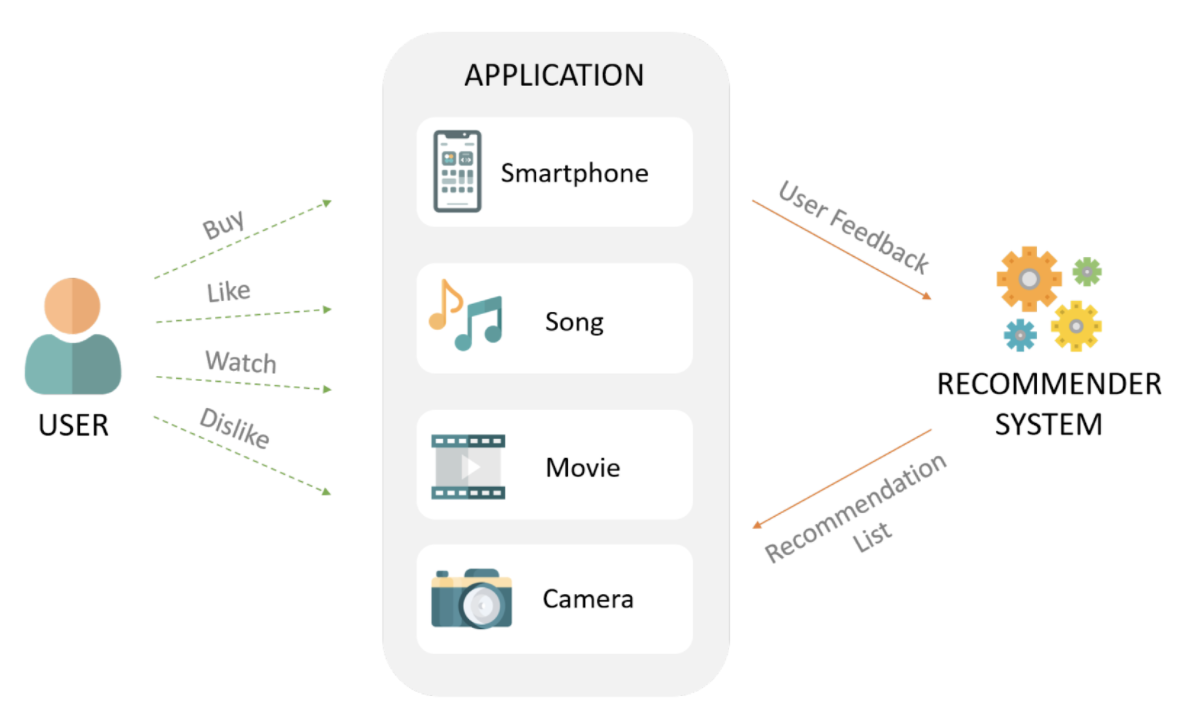 Recommendation System predicts a user’s preference for a product and serves personalized recommendations based on the prediction.
When a service recommends more personalized offers, users are more likely to make a purchase. This is how many businesses use the insignt for monetization. In fact, 35% of Amazon’s transactions come from recommendation algorithm. 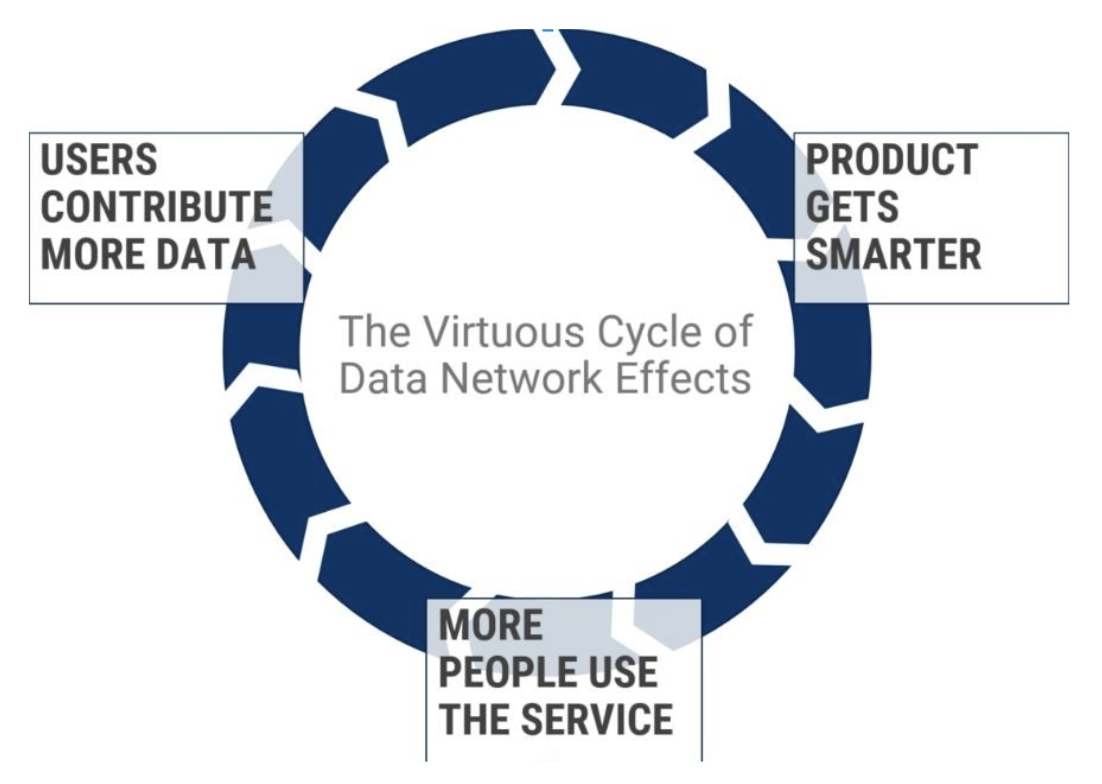
Type of RecommendationsFinding products with similar attributes
 Find products liked by users with similar interests
 Find complementary products
 How Amazon Uses Recommender SystemStep 1: data processing.
Batch processing is mainly used to gather basic data that don’t change often or don’t need to be updated in real time.
Streaming is mainly used to gather behavioral data that need to be updated in real time.
Gathered data are transformed into appropriate format (e.g. JSON, CSV, etc.) and provided to the machine learning model.
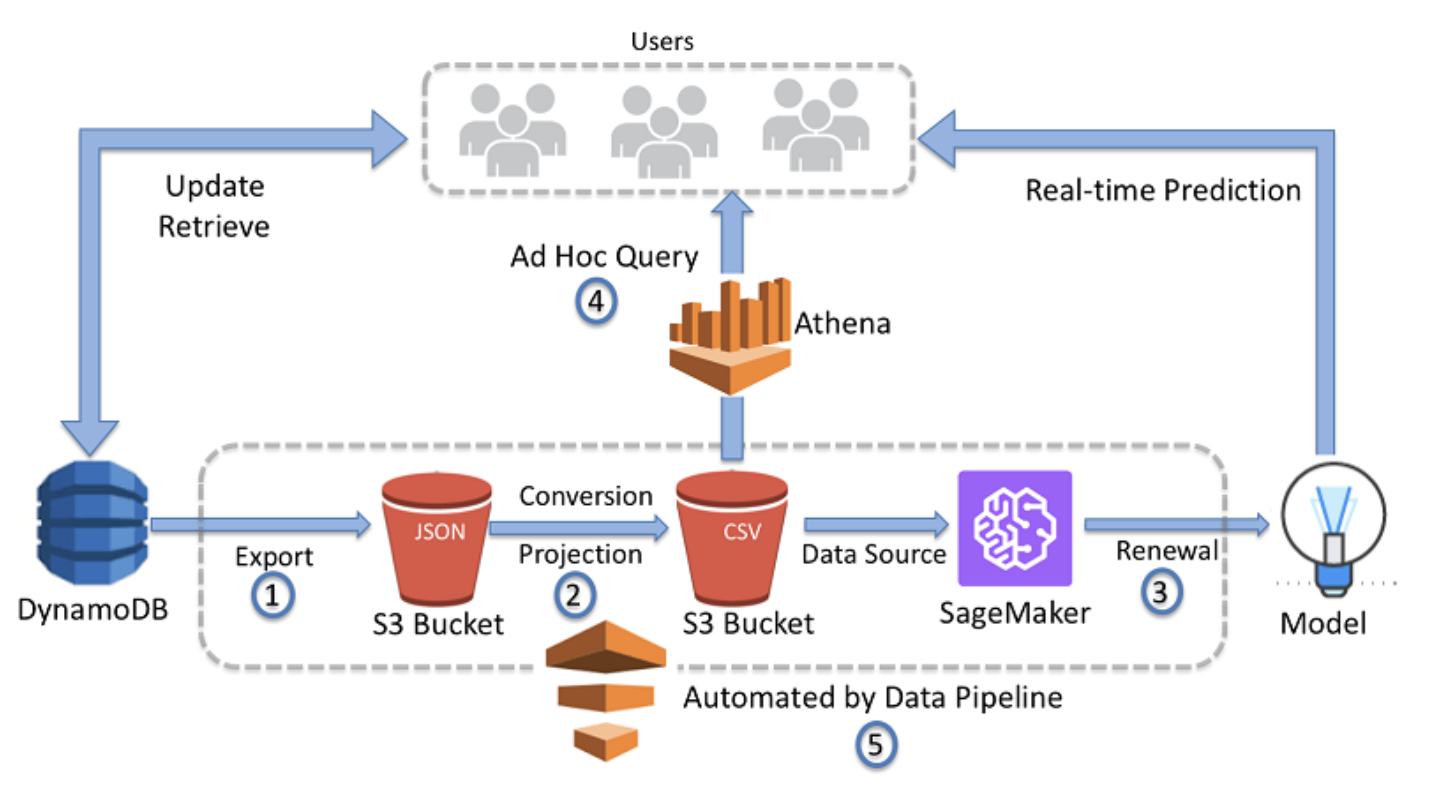
Deep Learning for Recommender Systems: A Netflix Case Study
Deep learning has profoundly impacted many areas of machine learning. However, it took a while for its impact to be felt in the field of recommender systems. In this article, we outline some of the challenges encountered and lessons learned in using deep learning for recommender systems at Netflix. We first provide an overview of the various recommendation tasks on the Netflix service. We found that different model architectures excel at different tasks. Even though many deep-learning models can be understood as extensions of existing (simple) recommendation algorithms, we initially did not observe significant improvements in performance over well-tuned non-deep-learning approaches. Only when we added numerous features of heterogeneous types to the input data, deep-learning models did start to shine in our setting. We also observed that deep-learning methods can exacerbate the problem of offline–online metric (mis-)alignment. After addressing these challenges, deep learning has ultimately resulted in large improvements to our recommendations as measured by both offline and online metrics. On the practical side, integrating deep-learning toolboxes in our system has made it faster and easier to implement and experiment with both deep-learning and non-deep-learning approaches for various recommendation tasks. We conclude this article by summarizing our take-aways that may generalize to other applications beyond Netflix. 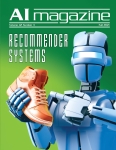 How to Cite
Information
Developed ByPart of the PKP Publishing Services Network Copyright © 2021, Association for the Advancement of Artificial Intelligence. All rights reserved.  Book a DemoMultiply your Shopify Store's Revenue with Personalization 30 day free-trialTry Argoid for your business now! Get product recommendation ribbons like 'Trending', 'Similar Products' and more, to improve conversion and sales Try Argoid, risk-free 5 Use Case Scenarios for Recommendation Systems and How They Help SHARE THIS BLOGThe market for recommendation engines is projected to grow from USD 1.14B in 2018 to 12.03B by 2025 with a CAGR of 32.39%, for the forecasted period. These figures are an indication of the growing emphasis on customer experience while also being a byproduct of the widespread proliferation of data. On that note, here are five practical use cases of recommendation systems across different industry verticals. Use these to understand the multiple ways in which recommendation systems can add value to your business. Five Practical Use Cases of Recommendation Systems1. ecommerce recommendations. 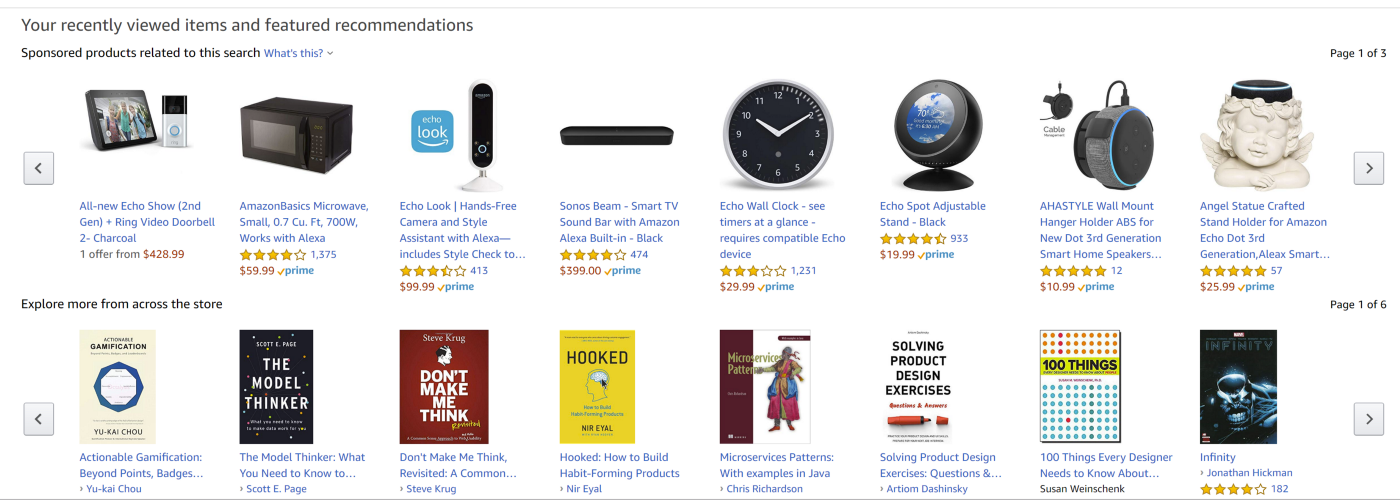 eCommerce is by far the commonest and most frequently encountered use case of recommendation systems in action. Amazon was a pioneer in introducing this change back in 2012 by making use of item-item collaborative filtering to recommend products to the buyers. The result? A resounding 29% uplift in sales in comparison to the performance in the previous quarter! Soon enough, the recommendation engine contributed to 35% of purchases made on the platform, which was bound to impact the bottom line of the eCommerce giant. To this date, Amazon continues to remain a market leader by virtue of its helpful and user-friendly recommender engine that now also extends to the streaming platform - Amazon Prime (more on this later). The recommendation system is designed to intuitively understand and predict account interest and behaviors to drive purchases, boost engagement, increase cart volume, up-sell and cross-sell, and prevent cart abandonment. Other retailers like ASOS, Pandora, and H&M utilize recommender systems to achieve a gamut of favorable results. 2. Media Recommendations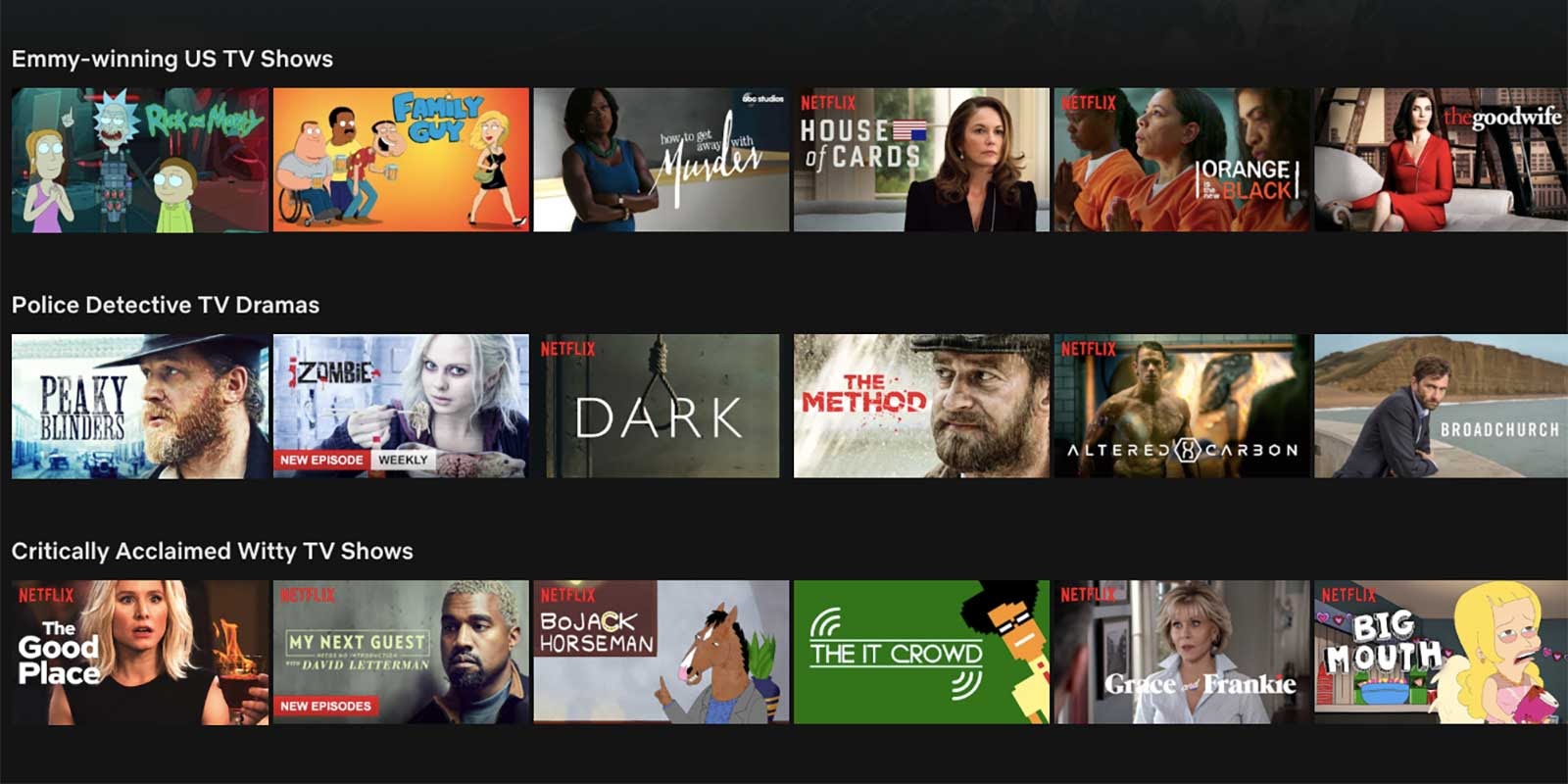 If Amazon is a frontrunner in the recommendation engine race, platforms like Netflix, Spotify, Prime Video, YouTube, and Disney+ are consolidating the role of recommendations in the field of media, entertainment, publishing, etc. Such channels have successfully normalized recommendation systems in the real world. Typically, most media streaming service providers employ a relational understanding of the type of content consumed by the user to suggest fresh content accordingly. Additionally, the self-learning and self-training aspect of AI in recommendation engines improves relevancy to maintain high levels of engagement while preventing customer churn. Consider Netflix, for example. About 75% of what users watch on Netflix is a result of its product recommendation algorithm. As a result, it is unsurprising that the platform has pegged its personalized recommendation engine at a whopping USD 1B per year as it maintains sustained subscription rates and delivers an impressive ROI that the company can redirect in fresh content creation. 3. Video Games and Stores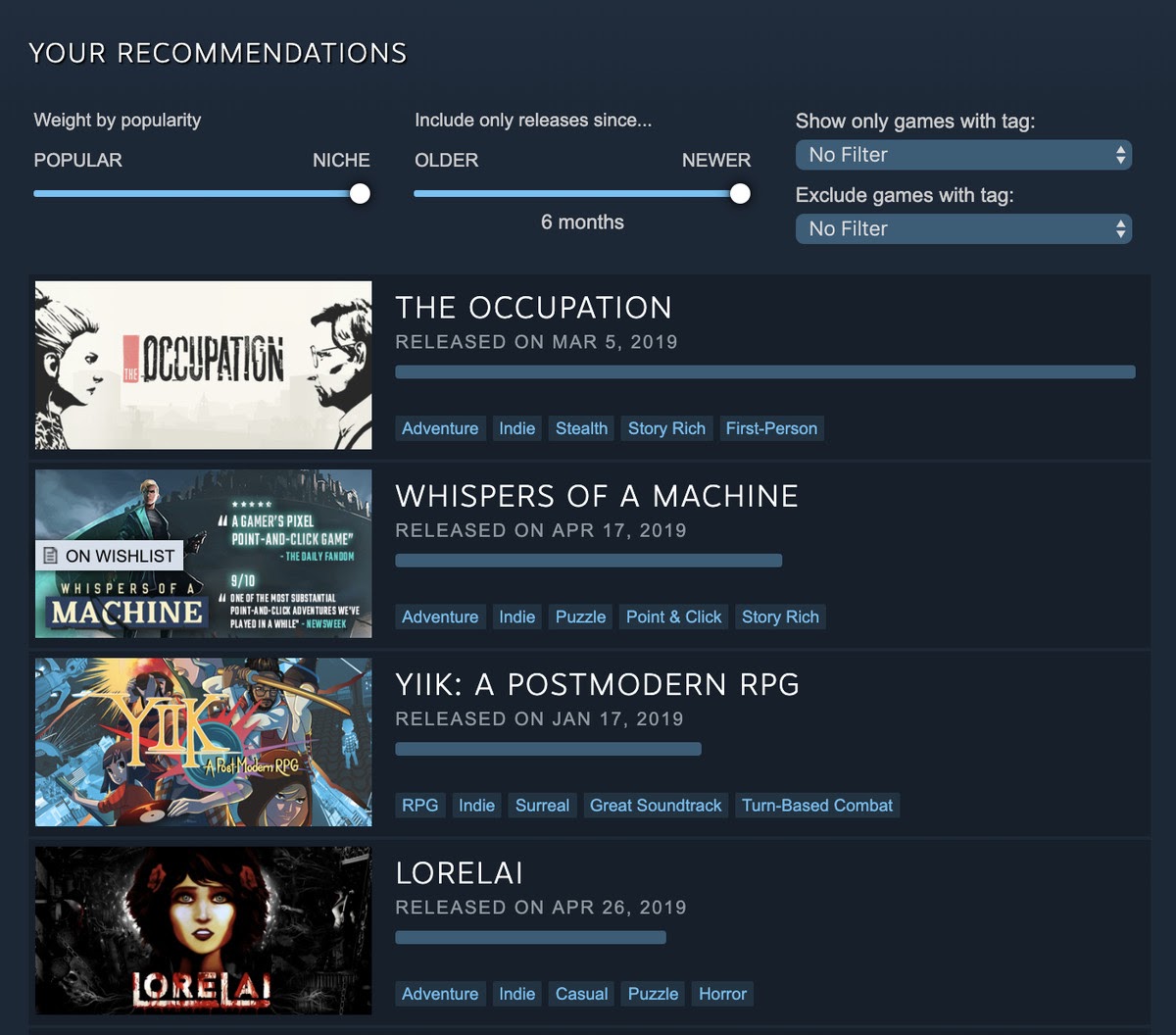 Video games are a treasure trove of user-generated data as it contains everything - from the games they play to the choices they make. This stored repository of action, reaction, and behavior translates into usable data that allows developers to curate the experience to maximize revenue without coming off as pushy or annoying. Gaming platforms like Steam, Xbox Games Store, PlayStation Store are already well-known for their excellent recommender engines that suggest games based on the player’s gaming history, browsing history, and purchase history. As such, someone who has an interest in battle royale games like Fortnite will recommend games like PUBG, Apex Legends, and CoD rather than MMORPGs like WoW. Similarly, video games can also deploy recommender systems to nudge players towards the top of the micro-transactions funnel to make the gaming experience easier or more rewarding. Apart from boosting engagements and in-game purchases, AI-based recommender algorithms can unlock cross-selling and up-selling opportunities. 4. Location-Based Recommendations Geographic location can be a demographic factor that acts as a glue between the online and offline customer experience. It can augment marketing, advertising, and sales efforts to improve overall profitability. As a result, businesses have been in the works of developing a reliable location-based recommender system (LBRS) or a location-aware recommender system (LARS) for quite a while now, and have registered successful results. Sephora, for instance, issues geo-triggered app notifications alerting customers on existing promos and offers when they are in the vicinity of a physical store. The Starbucks app also follows a similar system for recommending happy hours and store locations. An extension of this feature is seen in Foursquare, a local search-and-discovery mobile app, which matches users with establishments like local eateries, breweries, or activity centers, based on customer location and preferences. In the process, it maintains high engagement levels and promotes businesses in the same breath. 5. Health and Fitness Health and fitness is one of the newest entrants in the recommender system but enjoys immense potential because of this lag. Applications can capture user inputs, such as their dietary preferences, activity levels, fitness goals, height and weight, BMI, etc., to suggest customized diet plans, recipes, or workout routines to match their fitness goals. In addition to logging data on such platforms, its integration with wearable devices can streamline its ability to make more accurate and valuable suggestions - such as suggesting meditation or mindfulness exercises to high-risk groups upon registering elevated vitals. Most importantly, it can capture user feedback on their fitness journey and experiences in the form of ratings to fine tune the plan and make the recommendation smarter and more personalized. Say, someone is dissatisfied with the level of difficulty of the exercise regimen, then the app can recalibrate it to suit their abilities. Final WordsRecommendations have become an implicit customer expectation as they no longer wish to sift through stores and websites or find things that they do not like. As a result, AI-based content recommendation engines, such as the one developed by Argoid , are no longer a “nice-to-have” feature but the life blood for your business. Talk to us to know more! FAQs on Recommendation System Use CasesWhat is a recommendation system. A recommendation system uses the process of information filtering to predict the products a user will like and accordingly rate the products based on users' preferences. A recommender system easily highlights the most relevant products to the users and ensures faster conversion. Why recommendation systems are essential for eCommerce stores?A recommendation system makes the shopping journey simpler and enjoyable for users. With a recommendation system, you can get product recommendations with minimum search efforts and create long-term engagement. Which recommendation system should you use?A recommendation system that you must use is - Argoid. It helps with 1:1 personalized product recommendations for your eCommerce store and ensures faster conversion and retention. Similar blogs recommended for you Revolutionizing TV Content Scheduling with AI: Introducing Argoid’s FAST Channel AI Co-PlannerLearn about Argoid's FAST channel AI Co-planner  The Rise of FAST: How Ad-Supported Streaming is Changing TVA brief on what is FAST and it is changing the television .png) Framing the Future: How Streaming Media Recommendation Engines Can Transform Your Content StrategyLearn how you can leverage streaming streaming media recommendation engines to transform your content strategy Try Argoid for your businessZero setup fee . comprehensive product . packages that suit your business..  AI-powered real-time relevance for your viewers!  Subscribe to our newsletterGet the latest on AI in eCommerce and Streaming/OTT, AI-based recommendation systems and hyper-personalization. A Case Study on Recommendation Systems Based on Big Data

Part of the book series: Smart Innovation, Systems and Technologies ((SIST,volume 105)) 1606 Accesses Recommender systems mainly utilize for finding and recover contents from large datasets; it has been determining and analysis based on the scenario—Big Data. In this paper, we describe the process of recommendation system using big data with a clear explanation in representing the operation of mapreduce. We demonstrate the various stage of recommendation namely data collection rating, types of filtering. Analysis Scenario based drug recommender system, it consists of three components namely drug storage, cloud server, and recommender server. The system is evaluating with specific parameters like F-score, Precision, and recall. Finally, we describe the challenge of recommendation systems like data sparsity, cold start, sentimental analysis and No surprise. This is a preview of subscription content, log in via an institution to check access.  Access this chapterSubscribe and save.
Tax calculation will be finalised at checkout Purchases are for personal use only Institutional subscriptions Similar content being viewed by others Health Recommender Systems: A Survey Challenges and Issues of Recommender System for Big Data ApplicationsCadre: cloud-assisted drug recommendation service for online pharmacies. Bhosale, H.S., Gadekar, D.P.: A review paper on big data and Hadoop. Int. J. Sci. Res. Publ. 4 (10), 1–7 (2014) Google Scholar Verma, J.P., Patel, B., Patel, A.: Big data analysis: recommendation system with Hadoop framework. In: 2015 IEEE International Conference on Computational Intelligence and Communication Technology (CICT), pp. 92–97. IEEE, Feb 2015 Adomavicius, G., Tuzhilin, A.: Toward the next generation of recommender systems: a survey of the state-of-the-art and possible extensions. IEEE Trans. Knowl. Data Eng. 17 (6), 734–749 (2005) Article Google Scholar Zhao, Z.D., Shang, M.S.: User-based collaborative-filtering recommendation algorithms on Hadoop. In: Third International Conference on Knowledge Discovery and Data Mining, 2010. WKDD’10, pp. 478–481. IEEE, Jan 2010 Patil, S.N., Deshpande, S.M., Potgantwar, A.D.: Product recommendation using multiple filtering mechanisms on Apache spark (2017) Isinkaye, F.O., Folajimi, Y.O., Ojokoh, B.A.: Recommendation systems: principles, methods, and evaluation. Egypt. Inf. J. 16 (3), 261–273 (2015) Chen, R.C., Huang, Y.H., Bau, C.T., Chen, S.M.: A recommendation system based on domain ontology and SWRL for anti-diabetic drugs selection. Expert Syst. Appl. 39 (4), 3995–4006 (2012) Wang, H., Gu, Q., Wei, J., Cao, Z., Liu, Q.: Mining drug-disease relationships as a complement to medical genetics-based drug repositioning: where a recommendation system meets genome-wide association studies. Clin. Pharmacol. Ther. 97 (5), 451–454 (2015) Jamiy, F.E., Daif, A., Azouazi, M., Marzak, A.: The potential and challenges of Big data-Recommendation systems next level application. arXiv preprint arXiv: 1501.03424 (2015) Wali, M.N., Sree Prasanna, K., Surabhi, L.: An optimistic analysis of big data by using HDFS Dhavapriya, M., Yasodha, N.: Big data analytics: challenges and solutions using Hadoop, map reduce and big table. Int. J. Comput. Sci. Trends Technol. (IJCST) 4 (1) (2016) Bollier, D., Firestone, C.M.: The promise and peril of big data, p. 56. Aspen Institute, Communications, and Society Program, Washington, DC (2010) Helbing, D., Frey, B.S., Gigerenzer, G., Hafen, E., Hagner, M., Hofstetter, Y., Zwitter, A.: Will democracy survive big data and artificial intelligence? Scientific American. 25 Feb 2017 Azar, A.T., Vaidyanathan, S. (eds.): Advances in Chaos Theory and Intelligent Control, vol. 337. Springer (2016) Wiesner, M., Pfeifer, D.: Health recommender systems: concepts, requirements, technical basics, and challenges. Int. J. Environ. Res. Public Health 11 (3), 2580–2607 (2014) Yang, S., Zhou, P., Duan, K., Hossain, M.S., Alhamid, M.F.: emHealth: towards emotion health through depression prediction and intelligent health recommender system. Mob. Netw. Appl. 1–11 (2017) Holzinger, A.: Machine learning for health informatics. In: Machine Learning for Health Informatics, pp. 1–24. Springer International Publishing (2016) Aznoli, F., Navimipour, N.J.: Cloud services recommendation: reviewing the recent advances and suggesting the future research directions. J. Netw. Comput. Appl. 77 , 73–86 (2017) Sharma, S.K., Suman, U.: An efficient semantic clustering of URLs for web page recommendation. Int. J. Data Anal. Tech. Strat. 5 (4), 339–358 (2013) Ma, H., Yang, H., Lyu, M.R., King, I.: Sorec: social recommendation using probabilistic matrix factorization. In: Proceedings of the 17th ACM Conference on Information and Knowledge Management, pp. 931–940. ACM, Oct 2008 Melville, P., Mooney, R.J., Nagarajan, R.: Content-boosted collaborative filtering for improved recommendations. In: Aaai/iaai, pp. 187–192, July 2002 Schein, A.I., Popescul, A., Ungar, L.H., Pennock, D.M.: Methods and metrics for cold-start recommendations. In: Proceedings of the 25th Annual International ACM SIGIR Conference on Research and Development in Information Retrieval, pp. 253–260. ACM, Aug 2002 Sagiroglu, S., Sinanc, D.: Big data: a review. In: 2013 International Conference on Collaboration Technologies and Systems (CTS), pp. 42–47. IEEE, May 2013 Das, A.S., Datar, M., Garg, A., Rajaram, S.: Google news personalization: scalable online collaborative filtering. In: Proceedings of the 16th International Conference on World Wide Web, pp. 271–280. ACM, May 2007 Download references Author informationAuthors and affiliations. School of Information Technology and Engineering, VIT University, Vellore, 632014, TamilNadu, India M. Sandeep Kumar & J. Prabhu You can also search for this author in PubMed Google Scholar Corresponding authorCorrespondence to M. Sandeep Kumar . Editor informationEditors and affiliations. School of Computer Engineering, KIIT Deemed to be University, Bhubaneswar, Odisha, India Suresh Chandra Satapathy Department of Electronics and Communication Engineering, Shri Ramswaroop Memorial Group of Professional Colleges, Lucknow, Uttar Pradesh, India Vikrant Bhateja Electronics and Communication Sciences Unit, Indian Statistical Institute, Kolkata, West Bengal, India Swagatam Das Rights and permissionsReprints and permissions Copyright information© 2019 Springer Nature Singapore Pte Ltd. About this paperCite this paper. Sandeep Kumar, M., Prabhu, J. (2019). A Case Study on Recommendation Systems Based on Big Data. In: Satapathy, S., Bhateja, V., Das, S. (eds) Smart Intelligent Computing and Applications . Smart Innovation, Systems and Technologies, vol 105. Springer, Singapore. https://doi.org/10.1007/978-981-13-1927-3_44 Download citationDOI : https://doi.org/10.1007/978-981-13-1927-3_44 Published : 05 November 2018 Publisher Name : Springer, Singapore Print ISBN : 978-981-13-1926-6 Online ISBN : 978-981-13-1927-3 eBook Packages : Engineering Engineering (R0) Share this paperAnyone you share the following link with will be able to read this content: Sorry, a shareable link is not currently available for this article. Provided by the Springer Nature SharedIt content-sharing initiative
Policies and ethics
Recommendation Systems: Applications and Examples in 2024Cem is the principal analyst at AIMultiple since 2017. AIMultiple informs hundreds of thousands of businesses (as per Similarweb) including 60% of Fortune 500 every month. Cem's work focuses on how enterprises can leverage new technologies in AI, automation, cybersecurity(including network security, application security), data collection including web data collection and process intelligence. 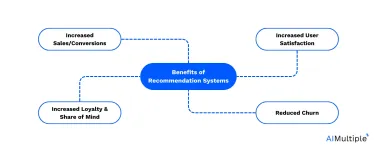 We adhere to clear ethical standards and follow an objective methodology . The brands with links to their websites fund our research. The recent global pandemic not only raised the demand for online shopping but also changed consumers’ behavior, as they required more personalized services from brands (Figure 1). As the e-commerce industry grows , the demand for recommendation systems will grow with it. If you are planning to leverage recommendation systems to enhance your online store, keep reading. In this article, we cover the following:
Figure 1. The importance of personalization in the post-pandemic market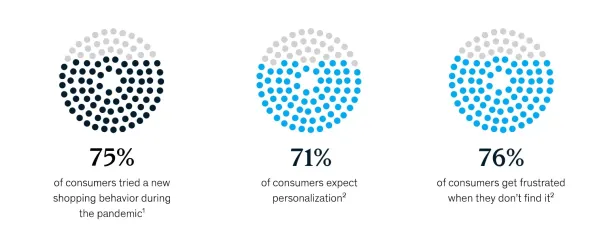 What is a recommendation system?It is easy to get confused about recommendation systems as they are also sometimes called recommender systems or recommendation engines. All of these perform the same actions; they are systems that predict what your customers want by analyzing their behavior which contains information on past preferences. How does it work?Recommendation systems collect customer data and auto-analyze it to generate customized recommendations for your customers. These systems rely on both:
Content-based filtering and collaborative filtering are two approaches commonly used to generate recommendations. For more, please read the approaches section of our list of recommendation system vendors . Benefits of recommendation systems1. increased sales/conversion. There are very few ways to achieve increased sales without increased marketing effort, and a recommendation system is one of them. Once you set up an automated recommendation system, you get recurring additional sales without any effort since it connects the shoppers with their desired products much faster. 2. Increased user satisfactionThe shortest path to a sale is great since it reduces the effort for both you and your customer. Recommendation systems allow you to reduce your customers’ path to a sale by recommending them a suitable option, sometimes even before they search for it. 3. Increased loyalty and share of mindBy getting customers to spend more on your website, you can increase their familiarity with your brand and user interface, increasing their probability of making future purchases from you. 4. Reduced churnRecommendation system-powered emails are one of the best ways to re-engage customers. Discounts or coupons are other effective yet costly ways of re-engaging customers, and they can be coupled with recommendations to increase customers’ probability of conversion. Applicable areasAlmost any business can benefit from a recommendation system. There are two important aspects that determine the level of benefit a business can gain from the technology.
With this framework, we can identify industries that stand to gain from recommendation systems: 1. E-CommerceIs an industry where recommendation systems were first widely used. With millions of customers and data on their online behavior, e-commerce companies are best suited to generate accurate recommendations. Target scared shoppers back in the 2000s when Target systems were able to predict pregnancies even before mothers realized their own pregnancies . Shopping data is the most valuable data as it is the most direct data point on a customer’s intent. Retailers with troves of shopping data are at the forefront of companies making accurate recommendations. Similar to e-commerce, media businesses are one of the first to jump into recommendations. It is difficult to see a news site without a recommendation system. A mass-market product that is consumed digitally by millions. Banking for the masses and SMEs are prime for recommendations. Knowing a customer’s detailed financial situation, along with their past preferences, coupled with data of thousands of similar users, is quite powerful. It Shares similar dynamics with banking. Telcos have access to millions of customers whose every interaction is recorded. Their product range is also rather limited compared to other industries, making recommendations in telecom an easier problem. 6. UtilitiesSimilar dynamics with telecom, but utilities have an even narrower range of products, making recommendations rather simple. Examples from companies that use a recommendation engine1. amazon.com. Amazon.com uses item-to-item collaborative filtering recommendations on most pages of their website and e-mail campaigns. According to McKinsey, 35% of Amazon purchases are thanks to recommendation systems. Some examples of where Amazon uses recommendation systems are Netflix is another data-driven company that leverages recommendation systems to boost customer satisfaction. The same Mckinsey study we mentioned above highlights that 75% of Netflix viewing is driven by recommendations. In fact, Netflix is so obsessed with providing the best results for users that they held data science competitions called Netflix Prize where one with the most accurate movie recommendation algorithm wins a prize worth $1,000,000. Every week, Spotify generates a new customized playlist for each subscriber called “Discover Weekly” which is a personalized list of 30 songs based on users’ unique music tastes. Their acquisition of Echo Nest, a music intelligence and data-analytics startup, enable them to create a music recommendation engine that uses three different types of recommendation models:
4. LinkedinJust like any other social media channel, LinkedIn also uses “You may also know” or “You may also like” types of recommendations. Setting up a recommendation systemWhile most companies would benefit from adopting an existing solution, companies in niche categories or very high scale could experiment with building their own recommendation engine. 1. Using an out-of-the-box solutionRecommendation systems are one of the earliest and most mature AI use cases. As of Jan/2022, we have identified 10+ products in this domain. Visit our guide on recommendation systems to see all the vendors and learn more about specific recommendation engines. The advantages of this approach include fast implementation and highly accurate results for most cases:
To pick the right system, you can use historical or, even better, live data to test the effectiveness of different systems quickly. 2. Building your own solutionThis can make sense if
Recommendation systems in the market today use logic like: customers with the similar purchase and browsing histories will purchase similar products in the future. To make such a system work, you either need a large number of historical transactions or detailed data on your user’s behavior on other websites. If you need such data, you could search for it in data marketplaces . More data and better algorithms improve recommendations. You need to make use of all relevant data in your company, and you could expand your customer data with 3rd party data. If a regular customer of yours has been looking for red sneakers on other websites, why shouldn’t you show them a great pair when they visit your website? 3. Working with a consultant to build your own solutionsA slightly better recommendation engine could boost a company’s sales by a few percentage points, which could make a dramatic change in the profitability of a company with low-profit margins. Therefore, it can make sense to invest in building better recommendation engines if the company is not having satisfactory results from existing solution providers in the market . AI consultants can help build specific models. We can help you identify partners in building custom recommendation engines: If you want to learn more about custom AI solutions, feel free to read our whitepaper on the topic: 4. Running a data science competition to build your own solutionOne possible approach is to use the wisdom of the crowd to build such systems. Companies can use encrypted historical data, launch data science competitions or work with consultants and get models providing highly effective recommendations. Further readingAI is not only applied to recommendation personalization. You can check out AI applications in marketing , sales , customer service , IT , data or analytics . If you have any questions about recommendation systems, let us know:  Cem's work has been cited by leading global publications including Business Insider, Forbes, Washington Post, global firms like Deloitte, HPE, NGOs like World Economic Forum and supranational organizations like European Commission. You can see more reputable companies and media that referenced AIMultiple. Cem's hands-on enterprise software experience contributes to the insights that he generates. He oversees AIMultiple benchmarks in dynamic application security testing (DAST), data loss prevention (DLP), email marketing and web data collection. Other AIMultiple industry analysts and tech team support Cem in designing, running and evaluating benchmarks. Throughout his career, Cem served as a tech consultant, tech buyer and tech entrepreneur. He advised enterprises on their technology decisions at McKinsey & Company and Altman Solon for more than a decade. He also published a McKinsey report on digitalization. He led technology strategy and procurement of a telco while reporting to the CEO. He has also led commercial growth of deep tech company Hypatos that reached a 7 digit annual recurring revenue and a 9 digit valuation from 0 within 2 years. Cem's work in Hypatos was covered by leading technology publications like TechCrunch and Business Insider. Cem regularly speaks at international technology conferences. He graduated from Bogazici University as a computer engineer and holds an MBA from Columbia Business School. To stay up-to-date on B2B tech & accelerate your enterprise: Next to ReadTop 5 tools for customer engagement automation in 2024, minimum advertised price (map): what it is & how to automate, top 6 use cases / applications of deep learning in finance in '24. Your email address will not be published. All fields are required. Related research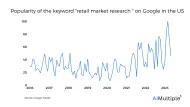 Retail Market Research: Benefits, Trends & 5 Real-Life Examples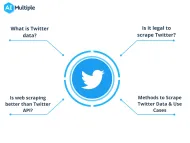 X (Twitter) Web Scraping: Legality, Methods & Use Cases 2024
 Recommendation engineRecostream is an AI/ML personalized recommendation engine offered as a SaaS service for online stores of any size. The software is built on the foundation of the Openkoda, utilizing a significant number of pre-existing features within the platform.  Recostream is a product recommendation engine built with Openkoda
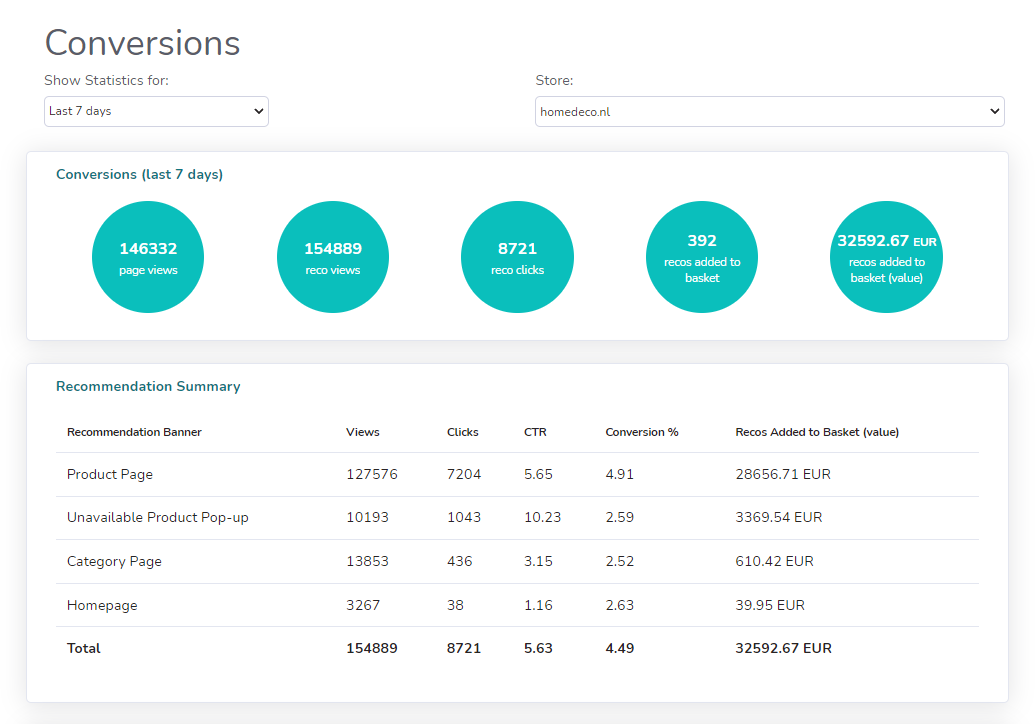 Key features of the application
The ambitious scope of the product and the fast-paced nature of the ecommerce industry required to:
Ideally, the implementation should focus on research and development of the recommendation engine’s machine learning algorithms, with the rest of the system delivered with minimal development effort, if possible.  Recostream’s engineering team decided to use Openkoda as the foundation for the recommendation service, as a significant number of ready-to-use Openkoda features were already available in the platform. The team started with a smaller PoC focused on building the prototype of the recommendation engine only, exploring and testing different machine learning algorithms and scaling the research prototypes to handle real, massive amounts of collected data describing shopping behavior and user interactions. Once the system was validated and promoted from the experimental phase to production, the same team of developers was able to take over Openkoda and build a full enterprise SaaS service around the engine, reusing a large number of features, components, and integrations that already existed in Openkoda. The engineering team of only 4 developers was able to evolve the bare prototype of the recommendation engine into a working product prototype and start the first implementations within two months after the PoC phase was completed. Such a short delivery time was made possible by adding their highly specialized IP behind the developed AI/ML recommendation engine to an enterprise-ready SaaS platform provided by Openkoda. Since the Openkoda platform is freely available as an open-source system under the MIT license , there were no licensing costs associated with using Openkoda in the project.  Recostream quickly became an industry-recognized product recommendation service for ecommerce stores of all sizes and was acquired two years later by GetResponse , a global leader in marketing automation. Read more about the product history and the acquisition . The Recostream product is now a part of the larger offering from GetResponse. What is Openkoda?Openkoda enables faster application development. This AI-powered open source platform provides pre-built application templates and customizable solutions to help you quickly build any functionality you need to run your business. With Openkoda, you can achieve up to 60% faster development and significant cost savings. Start streamlining your development process with Openkoda today. Reduce time-to-marketBuild enterprise applications based on openkoda, loved by developers.  Build business applications fasterOpen-source business application platform for fast development Laciarska 4 50-140 Wroclaw, Poland [email protected]
 Article ContentsIntroduction, methods and evaluation, conclusion and future work, acknowledgement, conflicts of interest..
A content-based dataset recommendation system for researchers—a case study on Gene Expression Omnibus (GEO) repository
Braja Gopal Patra, Kirk Roberts, Hulin Wu, A content-based dataset recommendation system for researchers—a case study on Gene Expression Omnibus (GEO) repository, Database , Volume 2020, 2020, baaa064, https://doi.org/10.1093/database/baaa064
It is a growing trend among researchers to make their data publicly available for experimental reproducibility and data reusability. Sharing data with fellow researchers helps in increasing the visibility of the work. On the other hand, there are researchers who are inhibited by the lack of data resources. To overcome this challenge, many repositories and knowledge bases have been established to date to ease data sharing. Further, in the past two decades, there has been an exponential increase in the number of datasets added to these dataset repositories. However, most of these repositories are domain-specific, and none of them can recommend datasets to researchers/users. Naturally, it is challenging for a researcher to keep track of all the relevant repositories for potential use. Thus, a dataset recommender system that recommends datasets to a researcher based on previous publications can enhance their productivity and expedite further research. This work adopts an information retrieval (IR) paradigm for dataset recommendation. We hypothesize that two fundamental differences exist between dataset recommendation and PubMed-style biomedical IR beyond the corpus. First, instead of keywords, the query is the researcher, embodied by his or her publications. Second, to filter the relevant datasets from non-relevant ones, researchers are better represented by a set of interests, as opposed to the entire body of their research. This second approach is implemented using a non-parametric clustering technique. These clusters are used to recommend datasets for each researcher using the cosine similarity between the vector representations of publication clusters and datasets. The maximum normalized discounted cumulative gain at 10 (NDCG@10), precision at 10 (p@10) partial and p@10 strict of 0.89, 0.78 and 0.61, respectively, were obtained using the proposed method after manual evaluation by five researchers. As per the best of our knowledge, this is the first study of its kind on content-based dataset recommendation. We hope that this system will further promote data sharing, offset the researchers’ workload in identifying the right dataset and increase the reusability of biomedical datasets. Database URL : http://genestudy.org/recommends/#/ In the Big Data era, extensive amounts of data have been generated for scientific discoveries. However, storing, accessing, analyzing and sharing a vast amount of data are becoming major bottlenecks for scientific research. Furthermore, making a large number of public scientific data findable, accessible, interoperable and reusable is a challenging task. The research community has devoted substantial effort to enable data sharing. Promoting existing datasets for reuse is a major initiative that gained momentum in the past decade ( 1 ). Many repositories and knowledge bases have been established for specific types of data and domains. Gene Expression Omnibus (GEO) (https://www.ncbi.nlm.nih.gov/geo/), UKBioBank (https://www.ukbiobank.ac.uk/), ImmPort (https://www.immport.org/shared/home) and TCGA (https://portal.gdc.cancer.gov/) are some examples of repositories for biomedical datasets. DATA.GOV archives the U.S. Government’s open data related to agriculture, climate, education, etc. for research use. However, a researcher looking for previous datasets on a topic still has to painstakingly visit all the individual repositories to find relevant datasets. This is a tedious and time-consuming process. An initiative was taken by the developers of DataMed (https://datamed.org) to solve the aforementioned issues for the biomedical community by combining biomedical repositories together and enhancing the query searching based on advanced natural language processing (NLP) techniques ( 1 , 2 ). DataMed indexes provides the functionality to search diverse categories of biomedical datasets ( 1 ). The research focus of this last work was retrieving datasets using a focused query. In addition to that biomedical and healthCAre Data Discovery Index Ecosystem (bioCADDIE) dataset retrieval challenge was organized in 2016 to evaluate the effectiveness of information retrieval (IR) techniques in identifying relevant biomedical datasets in DataMed ( 3 ). Among the teams participated in this shared task, use of probabilistic or machine learning based IR ( 4 ), medical subject headings (MeSH) term based query expansion ( 5 ), word embeddings and identifying named entity ( 6 ), and re-ranking ( 7 ) for searching datasets using a query were the prevalent approaches. Similarly, a specialized search engine named Omicseq was developed for retrieving omics data ( 8 ). Google Dataset Search (https://toolbox.google.com/datasetsearch) provides the facility to search datasets on the web, similar to DataMed. While DataMed indexes only biomedical domain data, indexing in Google Dataset Search covers data across several domains. Datasets are created and added to repositories frequently, which makes it difficult for a researcher to know and keep track of all datasets. Further, search engines such as DataMed or Google Dataset Search are helpful when the user knows what type of dataset to search for, but determining the user intent in web searches is a difficult problem due to the sparse data available concerning the searcher ( 9 ). To overcome the aforementioned problems and make dataset search more user-friendly, a dataset recommendation system based on a researcher’s profile is proposed here. The publications of researchers indicate their academic interest, and this information can be used to recommend datasets. Recommending a dataset to an appropriate researcher is a new field of research. There are many datasets available that may be useful to certain researchers for further exploration, and this important aspect of dataset recommendation has not been explored earlier. Recommendation systems, or recommenders, are an information filtering system that deploys data mining and analytics of users’ behaviors, including preferences and activities, for predictions of users’ interests on information, products or services. Research publications in recommendation systems can be broadly grouped as content-based or collaborative filtering recommendation systems ( 10 ). This article describes the development of a recommendation system for scholarly use. In general, developing a scholarly recommendation system is both challenging and unique because semantic information plays an important role in this context, as inputs such as title, abstract and keywords need to be considered ( 11 ). The usefulness of similar research article recommendation systems has been established by the acceptance of applications such as Google Scholar (https://scholar.google.com/), Academia.edu (https://www.academia.edu/), ResearchGate (https://www.researchgate.net/), Semantic Scholar (https://www.semanticscholar.org/) and PubMed (https://www.ncbi.nlm.nih.gov/pubmed/) by the research community. Dataset recommendation is a challenging task due to the following reasons. First, while standardized formats for dataset metadata exist ( 12 ), no such standard has achieved universal adoption, and researchers use their own convention to describe their datasets. Further, many datasets do not have proper metadata, which makes the prepared dataset difficult to reuse/recommend. Second, there are many dataset repositories with the same dataset in different formats, making recommendation a challenging task. Additionally, the dataset recommendation system should be scalable to the increasing number of online datasets. We cast the problem of recommending datasets to researchers as a ranking problem of datasets matched against the researcher’s individual publication(s). The recommendation system can be viewed as an IR system where the most similar datasets can be retrieved for a researcher using his/her publications. Data linking or identifying/clustering similar datasets have received relatively less attention in research on recommendation systems. Previous work on this topic includes ( 13–15 ). Reference ( 13 ) defined dataset recommendation as to the problem of computing a rank score for each of a set of target datasets ( D T ) so that the rank score indicates the relatedness of D T to a given source dataset ( D S ). The rank scores provide information on the likelihood of a D T to contain linking candidates for D S . Reference ( 15 ) proposed a dataset recommendation system by first creating similarity-based dataset networks, and then recommending connected datasets to users for each dataset searched. Despite the promising result this approach suffers from the cold start problem. Here cold start problem refers to the user’s initial dataset selection, where the user has no idea what dataset to select/search. If a user chooses a wrong dataset initially, then the system will always recommend wrong datasets to the user. Some experiments were performed to identify datasets shared in the biomedical literature ( 16–18 ). Reference ( 17 ) identified data shared in biomedical literature articles using regular expression patterns and machine learning algorithms. Reference ( 16 ) identified datasets in social sciences papers using a semi-automatic method. The last system reportedly performed well (F-measure of 0.83) in finding datasets in the da|ra dataset registry. Different deep learning methods were used to extract the dataset mentions in publication and detect mention text fragment to a particular dataset in the knowledge base ( 18 ). Further, a content-based recommendation system was developed for recommending literature for datasets in ( 11 ), which was the first step toward developing a literature recommendation tool by recommending relevant literature for datasets. This article proposes a dataset recommender that recommends datasets to researchers based on their publications. We collected dataset metadata (title and summary) from GEO and researcher’s publications (title, abstract and year of publication) from PubMed using name and curriculum vitae (CV) for developing a dataset recommendation system. A vector space model (VSM) is used to compare publications and datasets. We propose two novel ideas: A method for representing researchers with multiple vectors reflecting each researcher’s diverse interests. A system for recommending datasets to researchers based on their research vectors. For the datasets, we focus on GEO (https://www.ncbi.nlm.nih.gov/geo/). GEO is a public repository for high-throughput microarray and next-generation sequence functional genomics data. It was found that an average of 21 datasets was added daily in the last 6 years (i.e. 2014–19). This gives a glimpse of the increasing number of datasets being made available online, considering that there are many other online data repositories as well. Many of these datasets were collected at significant expense, and most of these datasets were used only once. We believe that reusability of these datasets can be improved by recommending these to appropriate researchers. Efforts on restructuring GEO have been performed by curating available metadata. In reference ( 19 ), the authors identified the important keywords present in the datasets descriptions and searched other similar datasets. Another task on restructuring the GEO database, ReGEO (http://regeo.org/) was developed by ( 20 ), who identified important metadata such as time points and cell lines for datasets using automated NLP techniques. We developed this dataset recommendation system for researchers as a part of the dataset reusability platform (GETc Research Platform(http://genestudy.org/)) for GEO developed at the University Texas Health Science Center at Houston. This website recommends datasets to users using their publications. The rest of the article is organized in the following manner. Section 2 provides an overview of GEO datasets and researcher publications. Methods used for developing the recommendation system and evaluation techniques used in this experiment are described in Section 3 . Section 4 describes results. Section 5 provides a discussion. Finally, conclusion and future directions are discussed in Section 6 . The proposed dataset recommendation system requires both dataset metadata and the user profile for which datasets will be recommended. We collected metadata of datasets from the GEO repository, and researcher publications from PubMed using their names and CVs. The data collection methods and summaries of data are discussed next. GEO DatasetsGEO is one of the most popular public repositories for functional genomics data. As of December 18, 2019, there were 122 222 series of datasets available in GEO. Histograms of datasets submitted to GEO per day and per year as presented in Figure 1 showed an increasing trend of submitting datasets to GEO, which justified our selection of this repository for developing the recommendation system.  Histogram of datasets submitted to GEO based on datasets collected on December 18, 2019  Overview of dataset indexing pipeline Statistics of datasets collected from GEO
For the present experiment, metadata such as title, summary, submission date and name of dataset creator(s) were collected from GEO and indexed in a database, as shown in Figure 2 . We also collected the PMIDs of articles associated with each dataset. However, many datasets did not have articles associated with them. The detailed information of collected datasets is presented in Table 1 . Out of a total of 122 222 GEO datasets, 89 533 had 92 884 associated articles, out of which 61 228 were unique. The maximum number of articles associated with the datasets (‘GSE15907’ and ‘GSE31312’) was 10. These articles were used to remove the publications that were not related to GEO. Further, we used the GEO-related publications for building word embeddings to be used for subsequent text normalization as outlined in Section 3 . Researcher publicationsA researcher’s academic interest can be extracted from publications, grants, talks, seminars and much more. All this information is typically available in the CV, but it is presented in the form of titles/short texts. Here, short texts imply limited information. Further, lack of standardization in CV formats poses challenges to parse the CVs. In this work, an alternative approach was undertaken, which is outlined next. Title and year of the researcher’s publications were present in the CV. However, we required title, abstract and year of publication for our experiment. A researcher’s list of publications (titles and abstracts) are easier to get from web sources such as Google Scholar, PubMed, Semantic Scholar and others. Unfortunately, the full texts of most scientific articles are not publicly available. Thus, for the present experiment, we used only the title and abstract of publications in identifying the researcher’s areas of research.  Overview of researcher’s publication extraction system to remove the author disambiguation Given a researcher, we searched the researcher’s name in PubMed using Entrez API (https://www.ncbi.nlm.nih.gov/books/NBK25 501/) and collected all the publications. Multiple researchers with exact same name might exist, thus, querying the name in PubMed might sometime result in publications from other researchers as well. This is a typical challenge of author disambiguation. However, there are a few attempts that have been undertaken to resolve the issue of author disambiguation, and one of them is ORCID (https://orcid.org). A researcher needs to provide ORCID id to access his/her ORCID details. However, to the best of our knowledge, many researchers in the biomedical domain did not have an associated ORCID account. Thus we used a simple method to disambiguate the authors by using their CVs. Initially, the recommendation system prompts a researcher to provide his/her name and a CV (or list of publications). Next, we collected the publications (titles, names, MeSH terms and year of publication) for a researcher from PubMed by searching his/her name. For removing the publications of other authors with the same name, titles of all collected publications from PubMed were matched against the titles present in the CV. In the case of a match, publications were kept for further processing. An overview of the technique used for the researcher’s publication collection is provided in Figure 3 . One of the limitations of the above publication collection method is that the publications could not be collected if they were not listed in PubMed. Further, the datasets used in the present experiments were from the biomedical domain, and the publications not listed in PubMed were less pertinent to biomedical datasets. For example, someone’s biomedical interests (in PubMed) may be more reliable markers for biomedical datasets than a theoretical computer science or statistics paper. Another downside is if the researcher’s CV may not be fully up-to-date. This section describes how the two main objects of interest (datasets and publications of researchers) were embedded in a vector space and then how these vectors were compared in order to make recommendations. First, both datasets and papers were treated as text objects: the text of a dataset includes its title and summary, while the text of a paper includes its title and abstract. Pre-processing was performed on both a researcher’s publications and datasets by removing the low-value stopwords, links, punctuation and junk words. Further, the nltk WordNet lemmatizer (https://www.nltk.org/_modules/nltk/stem/wordnet.html) was used to get the root forms of the words. Next, we describe the methods used for converting datasets and researchers into vectors. Dataset vector generationVSMs can be built from text in a variety of ways, each of which has its distinct advantages and thus merit experimentation. For the present experiment, we used TF-IDF because it achieved better results for related literature recommendation for datasets in ( 11 ). TF-IDF : For vocabulary W , each unique word w ∈ W is assigned a score proportional to its frequency in the text (term frequency, TF) and its inverse frequency in the full collection (inverse document frequency, IDF). We tuned parameters such as minimum document frequency (min-df) and maximum n-gram size. For the present study, we kept maximum n-gram size = 2 (i.e. unigrams and bigrams) as including the higher n-gram increases the sparsity as well as computational complexity. We converted each dataset into a vector using TF-IDF. For each dataset, the title and summary were preprocessed and normalized and then converted into a single vector. Finally, each publication vector (or publication cluster vector) is compared with dataset vectors to generate the recommendation score. Different methods for representing a researcher’s papers as vectors are discussed next. Researcher vector generationBaseline method. For the baseline method, we combined multiple text-derived paper vectors into a single researcher vector ( v r ) in the same vector space using Equation ( 1 ): where P r is the set of papers of a researcher r ; N r is the total number of papers of that researcher, and it acts as a normalization term; v p is the vector for a single paper p using TF-IDF; λ p is a recency penalty to favor more recent papers (thus better reflecting the researcher’s current interest). It is evident that a researcher will be interested in datasets recommended for his/her current work rather than the work performed a few years back. Thus, we penalized each of the paper vectors from a different year, as stated in Equation ( 2 ): where t is the difference between the current year and year of publication. k is the decaying function to decrease the rate proportional to its current value, and for the present study, we kept k =0.05. . Multi-interest dataset recommendation (MIDR)The baseline method for creating a researcher vector may be helpful for new researchers without many publications, whereas an established researcher may have multiple areas of expertise with multiple papers in each. Also, if the number of papers is imbalanced in multiple areas, then the above baseline method may not work. With a highly imbalanced set of publications this would obviously bias dataset recommendation to the dominant interest. For a more balanced set of interests that are highly dispersed, this mixture would result in the ‘centroid’ of these interests, which could be quite distinct from the individual interests. Both these cases are undesirable. The centroid of a researcher’s interests may not be of much interest to them (e.g. a researcher interested in mouse genomics and HIV vaccines may not be interested in mouse vaccines ). For example, initial experiments were performed on Researcher 1 (mentioned later in Section 4), and it was observed that the datasets recommended for a researcher were biased toward a single research area with the largest number of publications. For example, Researcher 1 has a dominant number of publications on HIV and the baseline system recommends only HIV datasets, even if Researcher 1 has multiple research areas. A critical limitation of the above baseline approach is that researchers can have multiple areas of expertise. We can easily build multiple vectors, each corresponding to a different expertise if we know how to properly group/cluster a researcher’s papers according to expertise or topic. However, parametric methods such as k-means clustering and latent Dirichlet allocation require specifying a priori how many clusters/topics to utilize. Generalizing the number of clusters is not possible due to a varying number of publications of researchers. Instead, our insight is that the more publications a researcher has, the more interests or areas of expertise he/she likely has as well, but this should be modeled as a ‘soft’ constraint rather than a ‘hard’ constraint. We propose to employ the non-parametric Dirichlet Process Mixture Model (DPMM) ( 21 ) to cluster papers into several groups of expertise.  High level architecture of proposed dataset recommendation DPMM : We employed a Gibbs Sampling-based Dirichlet Process Mixture Modeling for text clustering. DPMM offers the following advantages over its traditional counterparts. First, the number of text clusters need not be specified; second, it is relatively scalable and third, it is robust to outliers ( 22 ). The technique employs a collapsed Gibbs Sampling mechanism for Dirichlet process models wherein the clusters are added or removed based on the probability of a cluster associating with a given document. The scalability of the technique stems from the fact that word frequencies are used for text clustering. This reduces the computational burden significantly, considering the large number of samples associated with text processing problems. Further, the optimal number of clusters is likely to be chosen, as clusters with low association probability with documents are eliminated, and new clusters are created for documents that do not belong to selected clusters with high probability. For example, if a cluster c 1 contains five documents, each with low association probability, then the cluster c 1 is eliminated, and new clusters are initialized. In DPMM, the decision to create a new cluster is based on the number of papers to be clustered and the similarity of a given paper to previously clustered papers. Thus, researchers with many papers but few interests can still result in fewer clusters than a researcher with fewer papers but more interests. For example, our evaluation includes two researchers, one with 53 papers and one with 32; however, the DPMM resulted in five and six clusters, respectively. After clustering, we created a pseudo-researcher for each cluster using Equation ( 1 ), though one that can be tied back to the original researcher. The recommendation system uses these pseudo-researchers in its similarity calculations along the same lines as described above. Further, the α parameter was tuned to control the number of clusters ( 22 ). We describe tuning of the α parameter in Section 3.4. Text normalization : Text normalization plays an important role in improving the performance of any NLP system. We also implemented text normalization techniques to improve the efficiency of the proposed clustering algorithm. We normalized similar words by grouping them together and replacing them with the most frequent words in the same word group. For example, HIV, HIV-1, HIV/AIDS and AIDS were replaced with the most frequent word HIV . For identifying similar words, we trained a word2vec model on the articles from PubMed using Gensim (https://radimrehurek.com/gensim/). The datasets are related to gene expressions, while the articles collected from PubMed contain a variety of topics related to biomedicine and life sciences which may not be suitable for building a word embedding in the current study (since some of these articles are highly unrelated to the type of information in GEO). The articles before 1998 were removed as the research on micro-array data started during that year ( 23 ). The publications related to GEO are filtered using the MeSH terms. We also developed a MeSH term classification system for those publications without MeSH terms. More details on GEO related publications filtering can be found in ( 11 ). The similar words were identified using the most_similar function of word2vec . We only considered the top five similar words for each word using most_similar function. The normalized text was used for clustering. It was observed from the initial experiments that the text normalization improved clustering and resulted in the reduced number of clusters using DPMM. Dataset recommendationThe most similar datasets can be recommended to researchers simply by comparing the cosine similarity of the researcher and dataset vectors using Equation ( 3 ): where D is all the datasets that can be recommended to researcher r ; |$\cos(v_r, v_d)$| is the cosine similarity between researcher vector ( v r ) and dataset vector ( v d ). The high-level system architecture of the dataset recommendation system is shown in Figure 4 . This dataset recommendation system is initiated by a researcher (user) by submitting his/her name and CV (or list of publications). The name is searched in PubMed for publication details, and then titles of publications from PubMed were matched with publication titles in CV. The matched publications are then clustered using DPMM to identify research fields of the researcher. Finally, the top similar datasets are recommended using the calculated cosine similarity between the researcher vector (or researcher’s cluster vector) and dataset vectors. The researcher vector (or researcher’s cluster vector) is calculated using Equation ( 1 ). Three dataset recommendation systems are evaluated in this article: a baseline method using the researcher’s vector generation method and two proposed methods using the proposed researcher’s vector generation method. Baseline systemThe baseline system uses the researcher’s vector using Equation ( 1 ) of the baseline method in Section 3.2.1 . The top datasets are recommended after calculating the cosine similarity between the researcher’s vector and dataset vectors. This system reflects only one research field for each researcher. MIDR SystemThe cluster vectors are generated using the modified Equation ( 1 ). Here, cluster-specific research area vectors are created for each researcher, instead of a single vector for each researcher as in baseline system. Papers in a single cluster are multiplied with their recency factors and summed. Then, the summation was divided the number of papers in that cluster. This system uses multiple pseudo vectors for multiple clusters of a researcher ( |$v_{c_i}$| for i th cluster), indicating different research fields that a researcher might have, as mentioned in Section 3.2.2 . This system compares each cluster vector with the dataset vectors and recommends the top datasets by computing the cosine similarity among them. Finally, it merges all the recommended datasets in a round-robin fashion for all the clusters, so that the researcher is able to see various datasets related to different research fields together. MIDR System (Separate)This system is an extension of our proposed MIDR system. Some researchers liked the way recommended datasets were merged. However, other researchers wanted dataset recommendations for each cluster separately. For this reason, another system was developed where the recommended datasets were shown separately for each research cluster, allowing researchers to obtain different recommended datasets for different research interests. Number of clusters with varying α values for proposed α based on our initial evaluation. Abbreviations: P: Proposed, a: total number of clusters, b: number of clusters which contains more than one paper, c: number of clusters which contains only one paper
Tuning the α parameterA researcher with a higher number of publications is more likely to have more research interests. In this paper, research interests are represented as clusters, expressed as vectors. A Dirichlet process is non-parametric because, in theory, there can be an infinite number of clusters. By changing the α parameter, DPMM can vary the number of clusters. The α value is inversely related to the number of clusters, i.e. decreasing the α parameter in DPMM may increase the number of output clusters. Therefore, we propose an α value, which is also inversely related to the number of research publications. Further, the α value must stabilize after a certain threshold to avoid the formation of too many clusters, and it must be generalized to the number of publications. To this end, α is calculated as follows: where N is the total number of papers for a researcher. The α value is proposed based on manually observing the clusters and collecting feedback from different researchers. Apart from inherent requirements for setting α , Equation ( 4 ) maintains a reasonable number of clusters, which was found useful by most of the evaluators. Different α values and their corresponding number of clusters are provided in Table 2 . The number of clusters are divided into three categories: (a) total number of clusters, (b) number of clusters which contains more than one paper, (c) number of clusters which contains only one paper. We removed the clusters with one paper and used the clusters with two or more papers for recommending datasets. We observed that the number of clusters did not entirely depend upon the number of papers, a researcher had. Moreover, it largely reflected the number of research fields that the researcher participated in. For example, Researcher 2 had fewer publications than Researcher 1 and Researcher 3, but the number of clusters was more than the others. This shows that non-parametric clustering is a good technique for segmenting research areas. There is no existing labeled clustered publication datasets available for automatic evaluation. Again, manually evaluating the clusters was a time and resource-consuming task. It might be biased as the evaluation depends upon different judgments for different researchers. Thus, we implemented K-Means for comparing to the proposed DPMM. The automatic cluster comparison was performed using inter- and intra-cluster cosine similarity (IACCS) of words and MeSH terms in the publications, separately. IACCS was the mean cosine similarity of words or MeSH terms for each pair of papers in a given cluster. Considering a cluster of size n ( |$X=\{x_1, x_2, \dots x_n\}$| ), the IACCS can be formulated using Equation ( 5 ): where, x i and x j are the list of MeSH terms or words of the i th and j th paper, respectively, and |$\cos(x_i, x_j)$| is the cosine similarity between them. Finally, the mean of IACCS was calculated using the IACCS of individual clusters. We computed the mean cosine similarity between words or MeSH terms of papers within clusters to calculate the inter-cluster cosine similarity (ICCS). Considering n clusters ( |$c_1, c_2, \dots c_n$| ), ICSS can be formulated using Equation ( 6 ): where, c i and c j are the list of MeSH terms or words of all the papers in the i th and j th clusters, respectively, and |$\cos(c_i, c_j)$| is the cosine similarity between them. For the baseline comparison, publication vectors are created using TF-IDF, then K-Means is used to compute the publication clusters. K-Means is a parametric unsupervised clustering. We implemented K-Means with two and five clusters separately for comparison purposes. On the other hand, the tuning parameter proposed for DPMM resulted in a variable number of clusters for different researchers, and these clusters were used for comparison. Recommendation systemMean IACCS and ICCS for K-Means and DPMM (with different cluster sizes as mentioned in Table 2 ).
Being a novel task, no prior ground truth annotations exist for publication-driven dataset recommendation. Thus, we performed a manual evaluation for each developed dataset recommendation system. We asked researchers to rate each retrieved dataset based on their publications or publication clusters. The researchers included in this study have already worked on the datasets from GEO and published papers on these datasets. The rating criterion was how likely they want to work on the retrieved datasets. We asked them to rate using one to three ‘stars’, with three stars being the highest score. Later, normalized discounted cumulative gain (NDCG) at 10 and Precision at 10 (P@10) were calculated to evaluate different systems. The ratings are: 1 star [not relevant] : This dataset is not useful at all. 2 star [partially relevant] : This dataset is partially relevant to the publication cluster. The researcher has already used this dataset or maybe work on it in the future. 3 star [most relevant] : This dataset is most relevant to the publication cluster, and the researcher wants to work on this dataset as soon as possible. The primary evaluation metric used in this work is NDCG, which is a family of ranking measures widely used in IR applications. It has advantages compared to many other measures. First, NDCG allows each retrieved document to have a graded relevance, while most traditional ranking measures only allow binary relevance (i.e. each document is viewed as either relevant or not relevant). This enables the three-point scale to be directly incorporated into the evaluation metric. Second, NDCG involves a discount function over the rank while many other measures uniformly weight all positions. This feature is particularly important for search engines as users care about top-ranked documents much more than others ( 24 ). NDCG is calculated as follows: where rating ( i ) is the i th dataset rating provided by users. For the present study, we set p = 10 for the simplicity of manual annotation. The NDCG@10 for the baseline and MIDR systems is calculated using the ratings of only the top ten retrieved datasets. For the MIDR system (separate), there were multiple publication clusters for a single user, and for each publication cluster we recommended datasets separately. NDCG@10 was calculated for each publication cluster using the top ten datasets and later averaged to get a final NDCG@10 for a single researcher. For NDCG@10 calculation, the 1-star, 2-star and 3-star are converted to 0, 1 and 2, respectively. We also calculated P@10 (strict and partial) for the baseline and proposed systems. Strict considers only 3-star, while partial considers both 2- and 3-star results. The results presented in this study were evaluated using a total of five researchers (with an average of 32 publications) who already worked on GEO datasets. This is admittedly a small sample size, but is large enough to draw coarse comparisons on this novel task. We compared DPMM clustering with K-Means as mentioned in Section 3.5 . ICCS and mean IACCS values for different clustering methods are presented in Table 3 . In general, higher mean IACSS and lower ICCS generally indicate better clustering. However, this is not always the case, especially when the number of clusters are small, and each cluster contains multiple publications for a single researcher. In this situation, the IACSS for individual cluster decreases after being divided by the number of publication pairs in each cluster. Furthermore, DPMM and K-Means were comparable when the number of clusters produced by both were close to each other. For all the cases, DPMM had higher mean IACSS and lower ICCS than K-Means using words. This suggests that DPMM was well-suited for clustering a researcher’s publications into multiple research fields. Researcher-specific results of the dataset recommendation system are shown in Table 4 . The results for individual researchers are listed for all the systems. Metric-specific average results for all the systems are also shown in Table 4 . The baseline system did not have any publication clusters and all publications were vectorized using Equation ( 1 ). Next, the top ten similar datasets were used to evaluate the results of the baseline system and it obtained the average NDGC@10, P@10 (P) and P@10 (S) of 0.80, 0.69 and 0.45, respectively. The proposed MIDR system obtained the average NDCG@10, P@10 (P) and P@10 (S) of 0.89, 0.78 and 0.61, respectively. The proposed MIDR (separate) system obtained the average NDGC@10, P@10 (P) and P@10 (S) of 0.62, 0.45 and 0.31, respectively. For calculating NDCG@10 and P@10 in the proposed MIDR (separate) system, individual cluster scores were calculated first, and then divided by the total number of clusters. NDCG@10, partial and strict P@10 values of the different dataset recommendation systems based on three evaluators. Abbreviations: Partial: P; Strict: S
The proposed MIDR system performed better than the baseline system. The MIDR system recommended a variety of datasets involving multiple clusters/research fields as opposed to the baseline system recommended datasets from a single research field with the maximum number of publications. Performances of the baseline and proposed MIDR (separate) systems could not be directly compared. Evaluation of the MIDR (separate) system was performed over multiple clusters with ten datasets recommended for each cluster. In contrast, evaluation of the baseline system was performed only on 10 datasets, for example, for Researcher 1 in Table 4 , evaluations of baseline system and MIDR (separate) system were performed on 10 and 50 datasets, respectively. There were other advantages of the MIDR (separate) system over the baseline system, irrespective of higher NDCG@10 for the latter. The baseline system had a bias toward a specific research field which was eliminated in the MIDR (separate) system. For Researchers 1 and 2 in Table 4 , the datasets recommended by the baseline system were found in the results of two clusters/research fields (which had the maximum number of publications) in the proposed MIDR (separate) system. However, for Researcher 3 in Table 4 , recommended datasets of the baseline system were found in the results of only one research field (with the maximum number of publications) in the proposed MIDR (separate) system. For Researcher 1 in Table 4 , there were 31 papers with HIV keywords and those papers were not published recently. We penalized the papers according to the year of publication for all methods. However, the top datasets contained ‘HIV’ or related keywords for the baseline method. We manually checked the top 100 results and found that those were relevant to HIV . Whereas, the proposed MIDR system clustered the publications into different groups (such as HIV, Flu/Influenza , and others), which resulted in recommendations for different research fields. Therefore, Researcher 1 had the flexibility to choose the datasets after looking at the preferred clusters in the proposed MIDR or MIDR (separate) system. Similarly, the results of the MIDR and MIDR (separate) systems could not be directly compared. Evaluation of the MIDR system was performed based on 10 datasets recommended for each researcher, whereas evaluation of MIDR (separate) system was performed based on 10 recommended datasets for each research field (cluster), which could be more than 10 datasets if a researcher had more than one research fields (clusters). Hence, the NDCG@10 and P@10 scores of MIDR (separate) system were less than the MIDR system. For researchers looking to find specific types of datasets, a keyword-based IR system might be more useful. For researcher who generally wanted to find datasets related to their interests, but did not have a particular interest in mind, could benefit from our system. For instance, if a researcher wanted a regular update of datasets relevant to their interest, our method would be better suited. However, this proposed system may not be useful to early-stage researchers due to fewer publications. They may take advantage of the available dataset retrieval systems such as DataMed, Omicseq and Google Dataset Search; or the text-based dataset searching that we provided on the website. Error analysisFor some clusters, evaluators rated all recommended datasets as one star. In most of these cases, we observed that the research field of that cluster was out of the scope of GEO. In this case, the NDCG@10 score was close to 1, but the P@10 score was 0. This may be one of the reasons why NDCG@10 scores were much higher compared to P@10 scores.  Screenshots of dataset recommendation system Researcher 1 (up) and Researcher 2 (down). Initially, we had not identified whether the clusters were related to GEO or not. We recommended datasets for these unrelated clusters. For example, Researcher 2 in Table 4 had a paper cluster which was related to statistical image analysis. For this specific cluster, Researcher 2 rated all the recommended datasets as one star, which reduced the scores of the systems. Later, we identified a threshold by averaging the similarity scores of publications and datasets for each cluster, and were able to remove the clusters which were not related to GEO. The threshold was set to 0.05 for the present study, i.e. a cluster was not considered for evaluation or showing recommendation if the average similarity score of the top 10 datasets for that cluster was less than or equals to 0.05. This threshold technique improved the results of proposed systems by 3% for Researcher 2. However, a thorough investigation on threshold involving datasets from different biomedical domains is needed for future work. Further, a dislike button for each cluster may be provided, and users may press the dislike button if that cluster is not related to GEO datasets. Later, this information can be used to build a machine learning-based system to identify and remove such clusters from further processing. This will improve the usefulness and reduce time complexity of the proposed recommendation system. . LimitationsThe researchers’ names are searched in PubMed to collect their publications. Many recent conference/journal publications are not updated in PubMed. Further, if the researcher has most of his/her publications that did not belong to the biomedical domain, then there is a low chance of getting those papers in PubMed. This makes the dataset recommendation task harder. Authors might later be able to include a subset of their non-PubMed articles for consideration in dataset recommendation (e.g. bioRxiv preprints), but this work is currently limited to PubMed publications only. We used PubMed name search to find the titles of a researcher’s papers. Finally, the titles were matched with the text in the CV to get publications. If there is any typo in the CV, then that publication would be rejected from being processed in further steps. As we do not fully parse the CV, instead just performing string matching to find publications, there is a high chance of rejecting publications with small typos. The manual evaluation was performed by five researchers only. For each cluster, 10 datasets were recommended, and each researcher has to evaluate an average of 40 datasets. It was a time-consuming task for evaluators to check each of the recommended datasets. For manual evaluation, we required the human judges with expertise on the GEO datasets, which was challenging to find. Further research will entail the scaling of this evaluation process. GETc PlatformWe developed the GETc research platform that recommends datasets to researchers using the proposed methods. A researcher needs to provide his/her name (as in PubMed) and CV (or list of publications) in the website. After processing his/her publications collected from PubMed, the recommendation system recommends datasets from GEO. Researchers can provide feedback for the datasets recommended by our system based on the evaluation criteria mentioned in Section 3.5 . A screenshot of the dataset recommendation system is shown in Figure 5 . This platform also recommends datasets using texts/documents, where cosine similarity of text and datasets are calculated, and datasets with a high score are recommended to users. Apart from dataset recommendation, it can also recommend literature and collaborators for each dataset. The platform analyzes time-course datasets using a specialized analysis pipeline (http://genestudy.org/pipeline) ( 25 ). We believe that these functions implemented in the GETc platform will significantly improve the reusability of datasets. This work is the first step toward developing a dataset recommendation tool to connect researchers to relevant datasets they may not otherwise be aware of. The maximum NDGC@10, P@10 (P) and P@10 (S) of 0.89, 0.78 and 0.61 were achieved based on the proposed method (MIDR) using five evaluators. This recommendation system will hopefully lead to greater biomedical data reuse and improved scientific productivity. Similar dataset recommendation can be developed for different datasets from both biomedical and other domains. The next goal is to identify the clusters which are not related to datasets and used for recommendations in the present article. These clusters can be removed from further experiments. Later, we plan to implement other embedding methods and test the dataset recommendation system on a vast number of users. A user-specific feedback-based system can be developed to remove datasets from the recommendations. Several additional dataset repositories can be added in the future. Other APIs can also be added to retrieve more complete representation of researcher’s publication history. Availability: http://genestudy.org/recommends/#/ We thank Drs. H.M, J.T.C, A.G and W.J.Z. for their help in evaluating the results and comments on designing that greatly improved the GETc research platform. This project is mainly supported by the Center for Big Data in Health Sciences (CBD-HS) at School of Public Health, University of Texas Health Science Center at Houston (UTHealth) and partially supported by the Cancer Research and Prevention Institute of Texas (CPRIT) project RP170 668 (K.R., H.W.) as well as the National Institute of Health (NIH) (grant R00LM012104) (K.R.). None declared. Chen X. et al. . ( 2018 ) Datamed–an open source discovery index for finding biomedical datasets . Journal of the American Medical Informatics Association , 25 , 300 – 308 . doi: 10.1093/jamia/ocx121 Google Scholar Roberts K. et al. . ( 2017 ) Information retrieval for biomedical datasets: the 2016 biocaddie dataset retrieval challenge . Database , 2017 , 1 – 9 . doi: 10.1093/database/bax068 Cohen T. et al. . ( 2017 ) A publicly available benchmark for biomedical dataset retrieval: the reference standard for the 2016 biocaddie dataset retrieval challenge . Database , 2017 , 1 – 10 . doi: 10.1093/database/bax061 Karisani P. , Qin Z.S. and Agichtein E. et al. ( 2018 ) Probabilistic and machine learning-based retrieval approaches for biomedical dataset retrieval . Database , 2018 , 1 – 12 . doi: 10.1093/database/bax104 Wright T.B. , Ball D. and Hersh W. et al. ( 2017 ) Query expansion using mesh terms for dataset retrieval: Ohsu at the biocaddie 2016 dataset retrieval challenge . Database , 2017 , 1 – 9 . doi: 10.1093/database/bax065 Scerri A. et al. . ( 2017 ) Elsevier’s approach to the biocaddie 2016 dataset retrieval challenge . Database , 2017 , 1 – 12 . doi: 10.1093/database/bax056 Wei W. et al. . ( 2018 ) Finding relevant biomedical datasets: the UC San Diego solution for the biocaddie retrieval challenge . Database , 2018 , 1 – 10 . doi: 10.1093/database/bay017 Sun X. et al. . ( 2017 ) Omicseq: a web-based search engine for exploring omics datasets . Nucleic acids research , 45 , W445 – W452 . doi: 10.1093/nar/gkx258 Jansen B.J. et al. . ( 2007 ) Determining the user intent of web search engine queries . In Proceedings of the 16th international conference on World Wide Web . ACM , Banff, Alberta, Canada pp. 1149 – 1150 . Achakulvisut T. et al. . ( 2016 ) Science concierge: A fast content-based recommendation system for scientific publications . PloS one , 11 , e0158423. doi: 10.1371/journal.pone.0158423 Patra B.G. et al. . ( 2020 ) A content-based literature recommendation system for datasets to improve data reusability. A case study on Gene Expression Omnibus (GEO) datasets . Journal of Biomedical Informatics , 104 , 103399. doi: 10.1016/j.jbi.2020.103399 Sansone S.-A. et al. . ( 2017 ) Dats, the data tag suite to enable discoverability of datasets . Scientific data , 4 , 170059. doi: 10.1038/sdata.2017.59 Ellefi M.B. et al. ( 2016 ) Dataset recommendation for data linking: An intensional approach . In European Semantic Web Conference . Springer , Heraklion, Crete, Greece pp. 36 – 51 . Nunes B.P. et al. ( 2013 ). Combining a co-occurrence-based and a semantic measure for entity linking . In Extended Semantic Web Conference , Springer , Montpellier, France 548 – 562 . Srivastava K.S. ( 2018 ). Predicting and recommending relevant datasets in complex environments . US Patent App. 15/721,122. Ghavimi B. et al. ( 2016 ) Identifying and improving dataset references in social sciences full texts . arXiv preprint arXiv:1603.01774 Positioning and Power in Academic Players, Agents and Agendas IOS Press 105 – 114 . doi: 10.3233/978-1-61499-649-1-105 Piwowar H.A. and Chapman W.W. ( 2008 ) Identifying data sharing in biomedical literature . In AMIA Annual Symposium Proceedings . American Medical Informatics Association , Washington, D.C., USA Vol. 2008 , p 596. Prasad A. et al. . ( 2019 ) Dataset mention extraction and classification . In Proceedings of the Workshop on Extracting Structured Knowledge from Scientific Publications . Association for Computational Linguistics , Minneapolis, Minnesota, USA pp 31 – 36 . Li Z. , Li J. and Yu P. et al. . ( 2018 ) Geometacuration: a web-based application for accurate manual curation of gene expression omnibus metadata . Database , 2018 , 1 – 8 . doi: 10.1093/database/bay019 Chen G. et al. ( 2019 ) Restructured geo: restructuring gene expression omnibus metadata for genome dynamics analysis . Database , 2019 , 1 – 8 . doi: 10.1093/database/bay145 Neal R.M. ( 2000 ) Markov chain sampling methods for dirichlet process mixture models . Journal of computational and graphical statistics , 9 , 249 – 265 . Yin J. and Wang J. ( 2016 ) A model-based approach for text clustering with outlier detection . In Proceedings of the 2016 IEEE 32nd International Conference on Data Engineering (ICDE) . IEEE , Helsinki, Finland , pp 625 – 636 . Lenoir T. and Giannella E. ( 2006 ) The emergence and diffusion of dna microarray technology . Journal of biomedical discovery and collaboration , 1 , 11. doi: 10.1186/1747-5333-1-11 Wang Y. et al. . ( 2013 ) A theoretical analysis of ndcg ranking measures . In 26th Annual Conference on Learning Theory (COLT 2013) PMLR Princeton, NJ, USA . Vol. 8 . Carey M. et al. . ( 2018 ) A big data pipeline: Identifying dynamic gene regulatory networks from time-course gene expression omnibus data with applications to influenza infection . Statistical methods in medical research , 27 , 1930 – 1955 . doi: 10.1177/0962280217746719 Author notesCitation details: Patra,B.G., Roberts,K., Wu,H., A content-based dataset recommendation system for researchers—a case study on Gene Expression Omnibus (GEO) repository. Database (2020) Vol. 00: article ID baaa064; doi:10.1093/database/baaa064
Email alertsCiting articles via.
Affiliations
Oxford University Press is a department of the University of Oxford. It furthers the University's objective of excellence in research, scholarship, and education by publishing worldwide
This Feature Is Available To Subscribers OnlySign In or Create an Account This PDF is available to Subscribers Only For full access to this pdf, sign in to an existing account, or purchase an annual subscription. How To Make Recommendation in Case Study (With Examples) After analyzing your case study’s problem and suggesting possible courses of action , you’re now ready to conclude it on a high note. But first, you need to write your recommendation to address the problem. In this article, we will guide you on how to make a recommendation in a case study. Table of ContentsWhat is recommendation in case study, what is the purpose of recommendation in the case study, 1. review your case study’s problem, 2. assess your case study’s alternative courses of action, 3. pick your case study’s best alternative course of action, 4. explain in detail why you recommend your preferred course of action, examples of recommendations in case study, tips and warnings.  The Recommendation details your most preferred solution for your case study’s problem. After identifying and analyzing the problem, your next step is to suggest potential solutions. You did this in the Alternative Courses of Action (ACA) section. Once you’re done writing your ACAs, you need to pick which among these ACAs is the best. The chosen course of action will be the one you’re writing in the recommendation section. The Recommendation portion also provides a thorough justification for selecting your most preferred solution. Notice how a recommendation in a case study differs from a recommendation in a research paper . In the latter, the recommendation tells your reader some potential studies that can be performed in the future to support your findings or to explore factors that you’re unable to cover.  Your main goal in writing a case study is not only to understand the case at hand but also to think of a feasible solution. However, there are multiple ways to approach an issue. Since it’s impossible to implement all these solutions at once, you only need to pick the best one. The Recommendation portion tells the readers which among the potential solutions is best to implement given the constraints of an organization or business. This section allows you to introduce, defend, and explain this optimal solution. How To Write Recommendation in Case Study You cannot recommend a solution if you are unable to grasp your case study’s issue. Make sure that you’re aware of the problem as well as the viewpoint from which you want to analyze it .  Once you’ve fully grasped your case study’s problem, it’s time to suggest some feasible solutions to address it. A separate section of your manuscript called the Alternative Courses of Action (ACA) is dedicated to discussing these potential solutions. Afterward, you need to evaluate each ACA by identifying its respective advantages and disadvantages.  After evaluating each proposed ACA, pick the one you’ll recommend to address the problem. All alternatives have their pros and cons so you must use your discretion in picking the best among these ACAs. To help you decide which ACA to pick, here are some factors to consider:
You may also use a decision matrix to assist you in picking the best ACA 1 . This matrix allows you to rank the ACAs based on your criteria. Please refer to our examples in the next section for an example of a Recommendation formed using a decision matrix.  Provide your justifications for why you recommend your preferred solution. You can also explain why other alternatives are not chosen 2 .  To help you understand how to make recommendations in a case study, let’s take a look at some examples below. Case Study Problem : Lemongate Hotel is facing an overwhelming increase in the number of reservations due to a sudden implementation of a Local Government policy that boosts the city’s tourism. Although Lemongate Hotel has a sufficient area to accommodate the influx of tourists, the management is wary of the potential decline in the hotel’s quality of service while striving to meet the sudden increase in reservations. Alternative Courses of Action:
Recommendation: Upon analysis of the problem, it is recommended to implement ACA 1. Among all suggested ACAs, this option is the easiest to execute with the minimal cost required. It will not also impact potential profits and customers’ satisfaction with hotel service. Meanwhile, implementing ACA 2 might discourage customers from making reservations due to higher fees and look for other hotels as substitutes. It is also not recommended to do ACA 3 because reducing hotel services and privileges offered to customers might harm the hotel’s public reputation in the long run. The first paragraph of our sample recommendation specifies what ACA is best to implement and why. Meanwhile, the succeeding paragraphs explain that ACA 2 and ACA 3 are not optimal solutions due to some of their limitations and potential negative impacts on the organization. Example 2 (with Decision Matrix) Case Study: Last week, Pristine Footwear released its newest sneakers model for women – “Flightless.” However, the management noticed that “Flightless” had a mediocre sales performance in the previous week. For this reason, “Flightless” might be pulled out in the next few months. The management must decide on the fate of “Flightless” with Pristine Footwear’s financial performance in mind.
Decision Matrix Recommendation Based on the decision matrix above 3 , the best course of action that Pristine Wear, Inc. must employ is ACA 3 or selling “Flightless” shoes at lower prices to encourage more customers. This solution can be implemented immediately without the need for an excessive amount of financial resources. Since lower prices entice customers to purchase more, “Flightless” sales might perform better given a reduction in its price. In this example, the recommendation was formed with the help of a decision matrix. Each ACA was given a score of between 1 – 4 for each criterion. Note that the criterion used depends on the priorities of an organization, so there’s no standardized way to make this matrix. Meanwhile, the recommendation we’ve made here consists of only one paragraph. Although the matrix already revealed that ACA 3 tops the selection, we still provided a clear explanation of why it is the best.
Written by Jewel Kyle Fabula in Career and Education , Juander How Jewel Kyle FabulaJewel Kyle Fabula is a Bachelor of Science in Economics student at the University of the Philippines Diliman. His passion for learning mathematics developed as he competed in some mathematics competitions during his Junior High School years. He loves cats, playing video games, and listening to music. Browse all articles written by Jewel Kyle Fabula Copyright NoticeAll materials contained on this site are protected by the Republic of the Philippines copyright law and may not be reproduced, distributed, transmitted, displayed, published, or broadcast without the prior written permission of filipiknow.net or in the case of third party materials, the owner of that content. You may not alter or remove any trademark, copyright, or other notice from copies of the content. Be warned that we have already reported and helped terminate several websites and YouTube channels for blatantly stealing our content. If you wish to use filipiknow.net content for commercial purposes, such as for content syndication, etc., please contact us at legal(at)filipiknow(dot)net   | |||||||||||||||||||||||||||||||||||||||||||||||||||||||||||||||||||||||||||||||||||||||||||||||||||||||||||||||||||||||||||||||||||||||||||||||||||||||||||||||||||||||||||||||||||||||||||||||||||||||||||||||||||||||||||||||||||||||||||||||||||||||||||||||||||||||||||||||||||||||||||||||||||||||||||||||||||||||||||||||||||||||||||||||||||||||||||||||||||||||||||||||||||||||||||||||||||||||||||||||||||||||||||||||||||||||||||||||||||||||||||||||||||||||||||||||||||||||||||||||||||||||||||||||||||||||||||||||||||||||||||||||||||||||||||||||||||||||||||||||||||||||||||||||||||||||||||||||||||||||||||||||||||||||||||||||||||||||||||||||||||||||||||||||||||||||||||||||||||||||||||||||||||||||||||||||||||||||||||||||||||||||||||||||||||||||||||||||||||||||||||||||||||||||||||||||||||||||||||||||||||||||||||||||||||||||||||||||||||||||||||||||||||||||||||||||||||||||||||||||||||||||||||||||||||||||||||||||||||||||||||||||||||||||||||||||||||||||||||||||||||||||||||||||||||||||||||||||||||||||
|---|---|---|---|---|---|---|---|---|---|---|---|---|---|---|---|---|---|---|---|---|---|---|---|---|---|---|---|---|---|---|---|---|---|---|---|---|---|---|---|---|---|---|---|---|---|---|---|---|---|---|---|---|---|---|---|---|---|---|---|---|---|---|---|---|---|---|---|---|---|---|---|---|---|---|---|---|---|---|---|---|---|---|---|---|---|---|---|---|---|---|---|---|---|---|---|---|---|---|---|---|---|---|---|---|---|---|---|---|---|---|---|---|---|---|---|---|---|---|---|---|---|---|---|---|---|---|---|---|---|---|---|---|---|---|---|---|---|---|---|---|---|---|---|---|---|---|---|---|---|---|---|---|---|---|---|---|---|---|---|---|---|---|---|---|---|---|---|---|---|---|---|---|---|---|---|---|---|---|---|---|---|---|---|---|---|---|---|---|---|---|---|---|---|---|---|---|---|---|---|---|---|---|---|---|---|---|---|---|---|---|---|---|---|---|---|---|---|---|---|---|---|---|---|---|---|---|---|---|---|---|---|---|---|---|---|---|---|---|---|---|---|---|---|---|---|---|---|---|---|---|---|---|---|---|---|---|---|---|---|---|---|---|---|---|---|---|---|---|---|---|---|---|---|---|---|---|---|---|---|---|---|---|---|---|---|---|---|---|---|---|---|---|---|---|---|---|---|---|---|---|---|---|---|---|---|---|---|---|---|---|---|---|---|---|---|---|---|---|---|---|---|---|---|---|---|---|---|---|---|---|---|---|---|---|---|---|---|---|---|---|---|---|---|---|---|---|---|---|---|---|---|---|---|---|---|---|---|---|---|---|---|---|---|---|---|---|---|---|---|---|---|---|---|---|---|---|---|---|---|---|---|---|---|---|---|---|---|---|---|---|---|---|---|---|---|---|---|---|---|---|---|---|---|---|---|---|---|---|---|---|---|---|---|---|---|---|---|---|---|---|---|---|---|---|---|---|---|---|---|---|---|---|---|---|---|---|---|---|---|---|---|---|---|---|---|---|---|---|---|---|---|---|---|---|---|---|---|---|---|---|---|---|---|---|---|---|---|---|---|---|---|---|---|---|---|---|---|---|---|---|---|---|---|---|---|---|---|---|---|---|---|---|---|---|---|---|---|---|---|---|---|---|---|---|---|---|---|---|---|---|---|---|---|---|---|---|---|---|---|---|---|---|---|---|---|---|---|---|---|---|---|---|---|---|---|---|---|---|---|---|---|---|---|---|---|---|---|---|---|---|---|---|---|---|---|---|---|---|---|---|---|---|---|---|---|---|---|---|---|---|---|---|---|---|---|---|---|---|---|---|---|---|---|---|---|---|---|---|---|---|---|---|---|---|---|---|---|---|---|---|---|---|---|---|---|---|---|---|---|---|---|---|---|---|---|---|---|---|---|---|---|---|---|---|---|---|---|---|---|---|---|---|---|---|---|---|---|---|---|---|---|---|---|---|---|---|---|---|---|---|---|---|---|---|---|---|---|---|---|---|---|---|---|---|---|---|---|---|---|---|---|---|---|---|---|---|---|---|---|---|---|---|---|---|---|---|---|---|---|---|---|---|---|---|---|---|---|---|---|---|---|---|---|---|---|---|---|---|---|---|---|---|---|---|---|---|---|---|---|---|---|---|---|---|---|---|---|---|---|---|---|---|---|---|---|---|---|---|---|---|---|---|---|---|---|---|---|---|---|---|---|---|---|---|---|---|---|---|---|---|---|---|---|---|---|---|---|---|---|---|---|---|---|---|---|---|---|---|---|---|---|---|---|---|---|---|---|---|---|---|---|---|---|---|---|---|---|---|---|---|---|---|---|---|---|---|---|---|---|---|---|---|---|---|---|---|---|---|---|---|---|---|---|---|---|---|---|---|---|---|---|---|---|---|---|---|---|---|---|---|---|---|---|---|---|---|---|---|---|---|---|---|---|---|---|---|---|---|---|---|---|---|---|---|---|---|---|---|---|---|---|---|---|---|---|---|---|---|---|---|---|---|---|---|---|---|---|---|---|---|---|---|---|---|---|---|---|---|---|---|---|---|---|---|---|---|---|---|---|---|---|---|---|---|---|---|---|---|---|---|---|---|---|---|---|---|---|---|---|---|---|---|---|---|---|---|---|---|---|---|---|---|---|---|---|---|---|---|---|---|---|---|---|---|---|---|---|---|---|---|---|---|---|---|---|---|---|---|---|---|---|---|---|---|---|---|---|---|---|---|---|---|---|---|---|---|---|---|---|---|---|---|---|---|---|---|---|---|---|
IMAGES
VIDEO
COMMENTS
The study of the recommendation system is a branch of information filtering systems (Recommender system, 2020). Information filtering systems deal with removing unnecessary information from the data stream before it reaches a human. Recommendation systems deal with recommending a product or assigning a rating to item.
A Case Study on Recommendation Systems Based on Big Data: Proceedings of the Second International Conference on SCI 2018, Volume 2 January 2019 DOI: 10.1007/978-981-13-1927-3_44
On the practical side, integrating deep-learning toolboxes in our system has made it faster and easier to implement and experiment with both deep-learning and non-deep-learning approaches for various recommendation tasks. We conclude this article by summarizing our take-aways that may generalize to other applications beyond Netflix.
Amazon is the largest e-commerce brand in the world in terms of revenue and market share. ( Statista) In 2021, Amazon's net revenue from e-commerce sales was US$470 billion, and about 35 percent of all sales on Amazon happen via recommendations. This clearly elucidates the power of recommendations. In this case study, we look at how Amazon is ...
Content-Based vs. Collaborative Filtering approaches for recommender systems. (Image by author) Content-Based Approach. Content-based methods describe users and items by their known metadata.Each item i is represented by a set of relevant tags—e.g. movies of the IMDb platform can be tagged as"action", "comedy", etc. Each user u is represented by a user profile, which can created from ...
Abstract. This survey provides an exhaustive exploration of the evolution and current state of recommendation systems, which have seen widespread integration in various web applications. It focuses on the advancement of personalized recommendation strategies for online products or services. We categorize recommendation techniques into four ...
A Machine Learning Case Study for Recommendation System of movies based on collaborative filtering and content based filtering. Business Problem Netflix is all about connecting people to the movies they love.
There are majorly six types of recommender systems which work primarily in the Media and Entertainment industry: 1) Collaborative Recommender system. 2) Content-based recommender system. 3 ...
May 29, 2021. 1. In daily life we have used many social media application like FB, IG etc. but do you think how this platform will provide the friend recommendation alert. Also, the alert for the ...
A detailed review of various recommendation systems is presented and typically recommender systems are based on the keyword search which allows the efficient scanning of very large document collections. The goal of a recommender system is to generate relevant recommendations for users. It is an information filtering technique that assists users by filtering the redundant and unwanted data from ...
The goal of this chapter is to give an up-to-date overview of recommender systems techniques used in an industrial setting. We will give a high-level description the practical use of recommendation and personalization techniques. We will highlight some of the main lessons learned from the Netflix Prize. We will then use Netflix personalization ...
We examined case studies conducted over the previous six years (2017-2022), with a focus on 35 key studies selected from 1938 academic papers found using the CADIMA tool. ... Baskota, A.; Ng, Y.K. A graduate school recommendation system using the multi-class support vector machine and KNN approaches. In Proceedings of the 2018 IEEE ...
We observe a number of studies in recommendation systems that utilize a variety of approaches, such as rule-based recommendation systems, case-based reasoning-based recommendation systems, and hybrid recommendations systems using collaborative filtering-based algorithms [18,19,20,21,22,23,24]. However, in this particular study, we propose a ...
Collaborative Filtering. Association Rules Learning. How Amazon Uses Recommender System. Step 1: Data Processing. Two Types of Data Processing. Gathering Basic Data - Batch Processing. Gathering Behavioral Data - Streaming. Step 2: Data Transformation. Step 3: Machine Learning Model Renewal.
In this article, we outline some of the challenges encountered and lessons learned in using deep learning for recommender systems at Netflix. We first provide an overview of the various recommendation tasks on the Netflix service. We found that different model architectures excel at different tasks. Even though many deep-learning models can be ...
to devise a better recommendation system for predictions. Mikolov et al[2] explore and evaluate a technique to embed natural language words in d-dimensional vector space, now commonly known as the word2vec model. The paper pro-poses multiple techniques to achieve this, which the paper *Equal contribution 1In CS229 2In CS224W. Correspondence
5 Use Case Scenarios for Recommendation Systems and How They Help. The market for recommendation engines is projected to grow from USD 1.14B in 2018 to 12.03B by 2025 with a CAGR of 32.39%, for the forecasted period. These figures are an indication of the growing emphasis on customer experience while also being a byproduct of the widespread ...
7 Case Study—(Drug Recommendation System—Medicines) Due to the quick improvement of e-commerce, most of the user preferring to buy medicine online for the sake of comfort. Moveover user does not realize issue while purchasing drug without the knowledge and proper guideless. Major problem while purchasing medicines for online site namely ...
With this framework, we can identify industries that stand to gain from recommendation systems: 1. E-Commerce. Is an industry where recommendation systems were first widely used. With millions of customers and data on their online behavior, e-commerce companies are best suited to generate accurate recommendations. 2.
Read how a recommendation engine was built on the foundation of the Openkoda, utilizing a significant number of pre-existing features within the platform. ... Case studies: Recostream. Recommendation engine. august 2020. ... Once the system was validated and promoted from the experimental phase to production, the same team of developers was ...
Recommender system has the ability to predict whether a particular user would prefer an item or not based on the user's profile. Recommender systems are beneficial to both service providers and users [3]. They reduce transaction costs of finding and selecting items in an online shopping environment [4].
Braja Gopal Patra, Kirk Roberts, Hulin Wu, A content-based dataset recommendation system for researchers—a case study on Gene Expression Omnibus (GEO) repository, Database, Volume 2020, 2020, ... The recommendation system can be viewed as an IR system where the most similar datasets can be retrieved for a researcher using his/her publications.
How To Write Recommendation in Case Study. 1. Review Your Case Study's Problem. 2. Assess Your Case Study's Alternative Courses of Action. 3. Pick Your Case Study's Best Alternative Course of Action. 4. Explain in Detail Why You Recommend Your Preferred Course of Action.